Research Report on Global Virtual Teams (GVTs)
VerifiedAdded on 2023/06/04
|17
|5441
|428
AI Summary
This research report provides a brief description about the global virtual teams in an organization within Australia. The report discusses the definition, characteristics, benefits, and problems caused by cultural diversification in GVTs. It also provides management strategies for dealing with the identified issues.
Contribute Materials
Your contribution can guide someone’s learning journey. Share your
documents today.
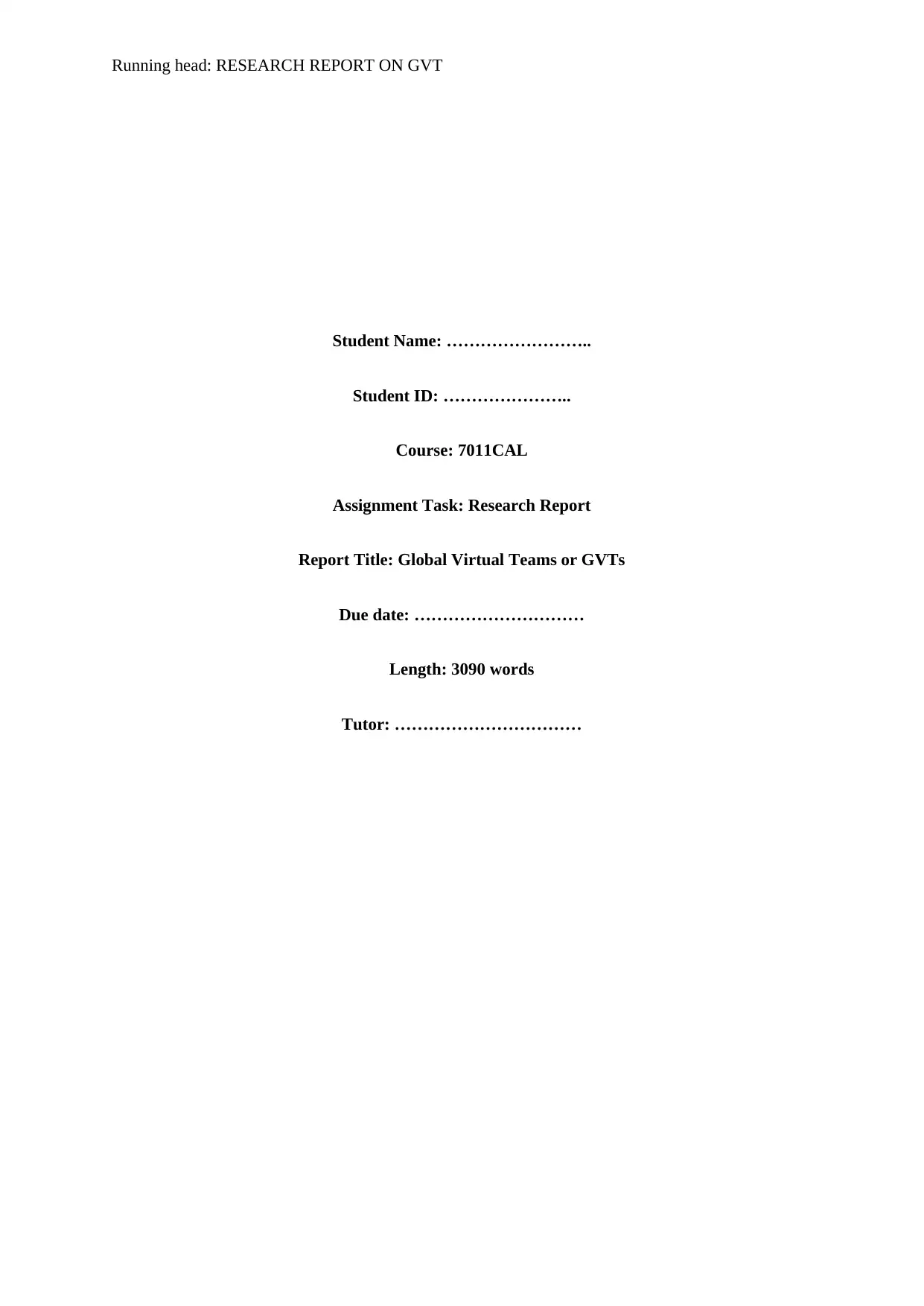
Running head: RESEARCH REPORT ON GVT
Student Name: ……………………..
Student ID: …………………..
Course: 7011CAL
Assignment Task: Research Report
Report Title: Global Virtual Teams or GVTs
Due date: …………………………
Length: 3090 words
Tutor: ……………………………
Student Name: ……………………..
Student ID: …………………..
Course: 7011CAL
Assignment Task: Research Report
Report Title: Global Virtual Teams or GVTs
Due date: …………………………
Length: 3090 words
Tutor: ……………………………
Secure Best Marks with AI Grader
Need help grading? Try our AI Grader for instant feedback on your assignments.
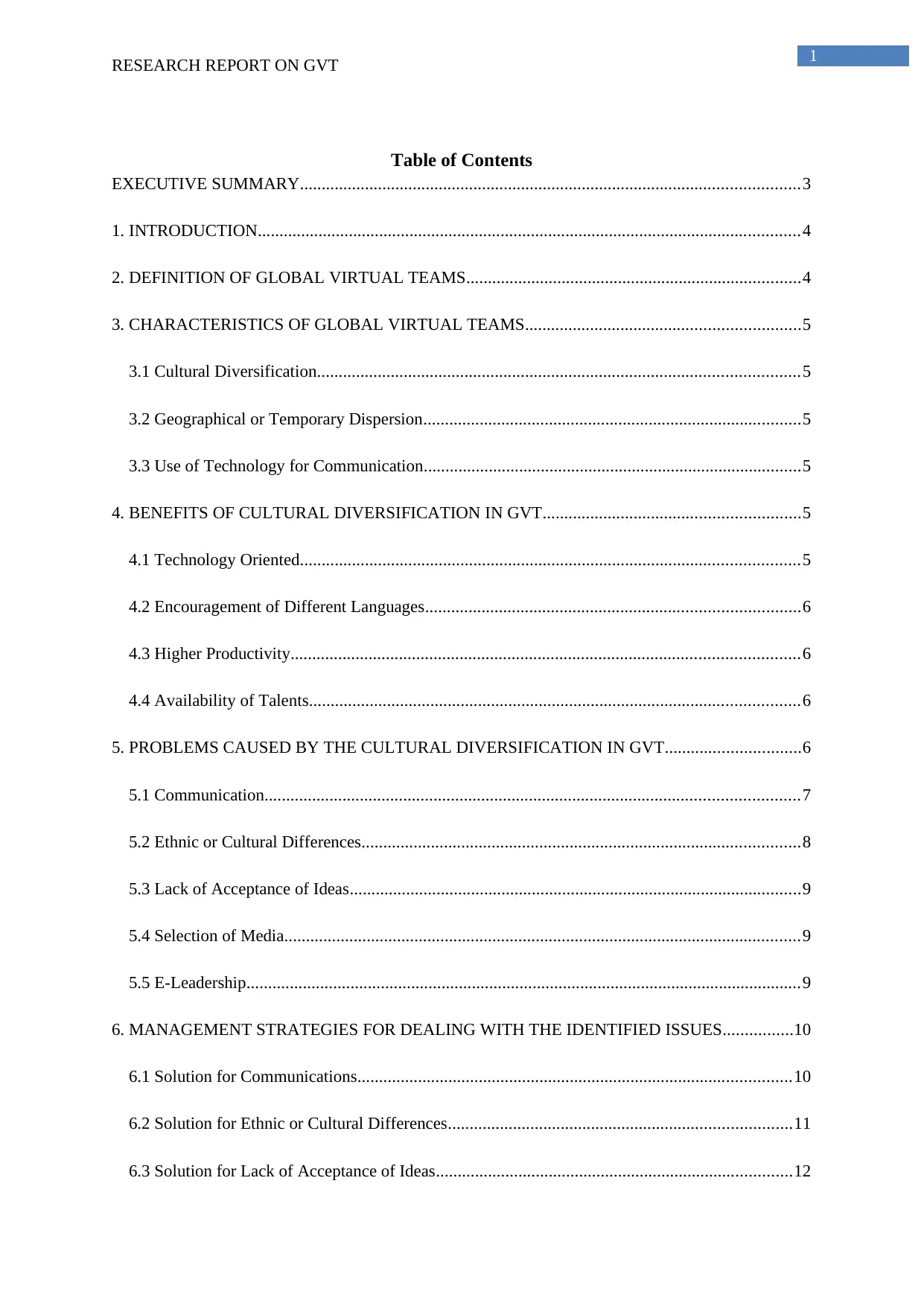
1
RESEARCH REPORT ON GVT
Table of Contents
EXECUTIVE SUMMARY...................................................................................................................3
1. INTRODUCTION.............................................................................................................................4
2. DEFINITION OF GLOBAL VIRTUAL TEAMS.............................................................................4
3. CHARACTERISTICS OF GLOBAL VIRTUAL TEAMS...............................................................5
3.1 Cultural Diversification...............................................................................................................5
3.2 Geographical or Temporary Dispersion.......................................................................................5
3.3 Use of Technology for Communication.......................................................................................5
4. BENEFITS OF CULTURAL DIVERSIFICATION IN GVT...........................................................5
4.1 Technology Oriented...................................................................................................................5
4.2 Encouragement of Different Languages......................................................................................6
4.3 Higher Productivity.....................................................................................................................6
4.4 Availability of Talents.................................................................................................................6
5. PROBLEMS CAUSED BY THE CULTURAL DIVERSIFICATION IN GVT...............................6
5.1 Communication...........................................................................................................................7
5.2 Ethnic or Cultural Differences.....................................................................................................8
5.3 Lack of Acceptance of Ideas........................................................................................................9
5.4 Selection of Media.......................................................................................................................9
5.5 E-Leadership................................................................................................................................9
6. MANAGEMENT STRATEGIES FOR DEALING WITH THE IDENTIFIED ISSUES................10
6.1 Solution for Communications....................................................................................................10
6.2 Solution for Ethnic or Cultural Differences...............................................................................11
6.3 Solution for Lack of Acceptance of Ideas..................................................................................12
RESEARCH REPORT ON GVT
Table of Contents
EXECUTIVE SUMMARY...................................................................................................................3
1. INTRODUCTION.............................................................................................................................4
2. DEFINITION OF GLOBAL VIRTUAL TEAMS.............................................................................4
3. CHARACTERISTICS OF GLOBAL VIRTUAL TEAMS...............................................................5
3.1 Cultural Diversification...............................................................................................................5
3.2 Geographical or Temporary Dispersion.......................................................................................5
3.3 Use of Technology for Communication.......................................................................................5
4. BENEFITS OF CULTURAL DIVERSIFICATION IN GVT...........................................................5
4.1 Technology Oriented...................................................................................................................5
4.2 Encouragement of Different Languages......................................................................................6
4.3 Higher Productivity.....................................................................................................................6
4.4 Availability of Talents.................................................................................................................6
5. PROBLEMS CAUSED BY THE CULTURAL DIVERSIFICATION IN GVT...............................6
5.1 Communication...........................................................................................................................7
5.2 Ethnic or Cultural Differences.....................................................................................................8
5.3 Lack of Acceptance of Ideas........................................................................................................9
5.4 Selection of Media.......................................................................................................................9
5.5 E-Leadership................................................................................................................................9
6. MANAGEMENT STRATEGIES FOR DEALING WITH THE IDENTIFIED ISSUES................10
6.1 Solution for Communications....................................................................................................10
6.2 Solution for Ethnic or Cultural Differences...............................................................................11
6.3 Solution for Lack of Acceptance of Ideas..................................................................................12

2
RESEARCH REPORT ON GVT
6.4 Solution for Selection of Media.................................................................................................12
6.5 Solution for E-Leadership..........................................................................................................13
7. CONCLUSION...............................................................................................................................13
References...........................................................................................................................................14
RESEARCH REPORT ON GVT
6.4 Solution for Selection of Media.................................................................................................12
6.5 Solution for E-Leadership..........................................................................................................13
7. CONCLUSION...............................................................................................................................13
References...........................................................................................................................................14
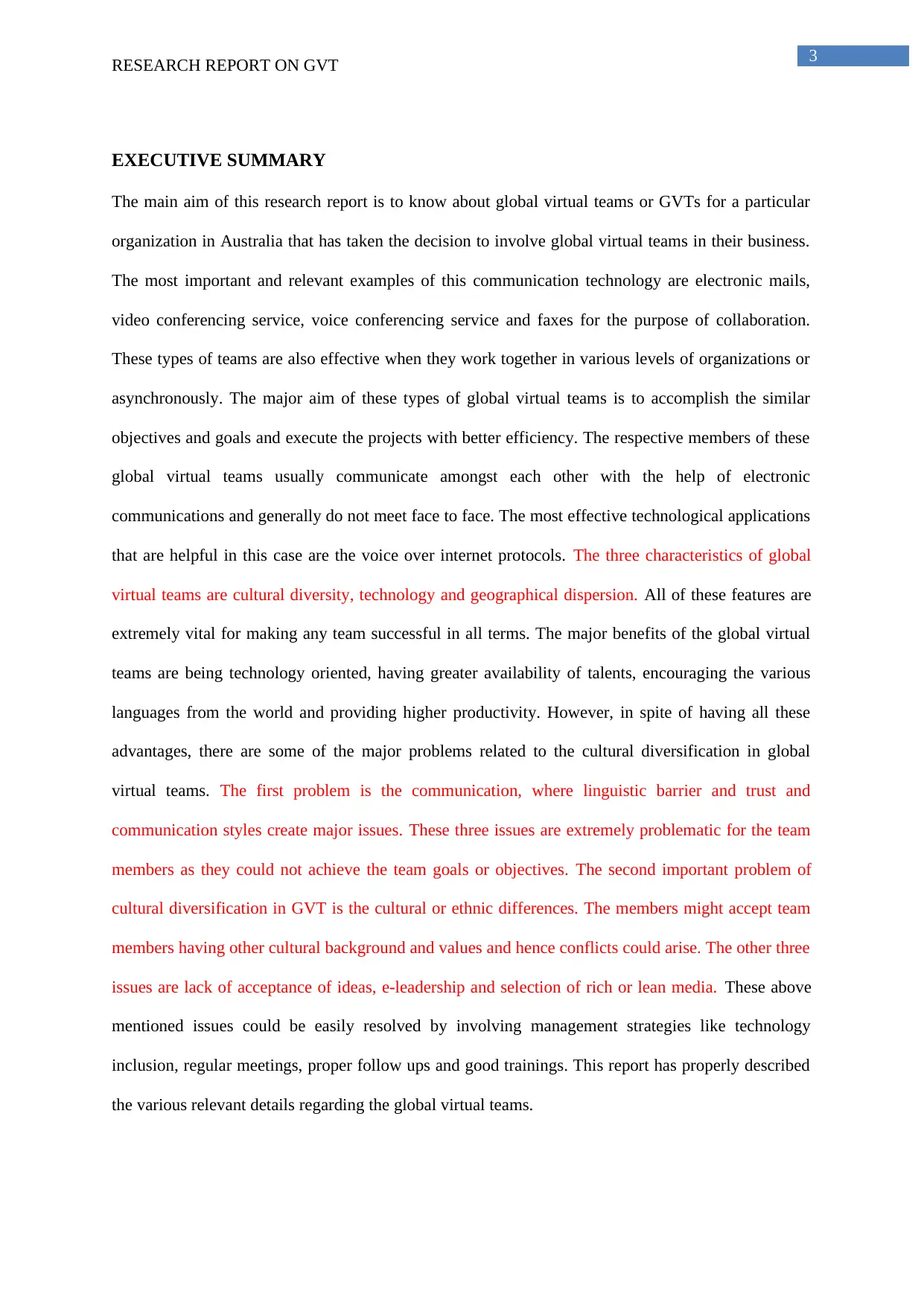
3
RESEARCH REPORT ON GVT
EXECUTIVE SUMMARY
The main aim of this research report is to know about global virtual teams or GVTs for a particular
organization in Australia that has taken the decision to involve global virtual teams in their business.
The most important and relevant examples of this communication technology are electronic mails,
video conferencing service, voice conferencing service and faxes for the purpose of collaboration.
These types of teams are also effective when they work together in various levels of organizations or
asynchronously. The major aim of these types of global virtual teams is to accomplish the similar
objectives and goals and execute the projects with better efficiency. The respective members of these
global virtual teams usually communicate amongst each other with the help of electronic
communications and generally do not meet face to face. The most effective technological applications
that are helpful in this case are the voice over internet protocols. The three characteristics of global
virtual teams are cultural diversity, technology and geographical dispersion. All of these features are
extremely vital for making any team successful in all terms. The major benefits of the global virtual
teams are being technology oriented, having greater availability of talents, encouraging the various
languages from the world and providing higher productivity. However, in spite of having all these
advantages, there are some of the major problems related to the cultural diversification in global
virtual teams. The first problem is the communication, where linguistic barrier and trust and
communication styles create major issues. These three issues are extremely problematic for the team
members as they could not achieve the team goals or objectives. The second important problem of
cultural diversification in GVT is the cultural or ethnic differences. The members might accept team
members having other cultural background and values and hence conflicts could arise. The other three
issues are lack of acceptance of ideas, e-leadership and selection of rich or lean media. These above
mentioned issues could be easily resolved by involving management strategies like technology
inclusion, regular meetings, proper follow ups and good trainings. This report has properly described
the various relevant details regarding the global virtual teams.
RESEARCH REPORT ON GVT
EXECUTIVE SUMMARY
The main aim of this research report is to know about global virtual teams or GVTs for a particular
organization in Australia that has taken the decision to involve global virtual teams in their business.
The most important and relevant examples of this communication technology are electronic mails,
video conferencing service, voice conferencing service and faxes for the purpose of collaboration.
These types of teams are also effective when they work together in various levels of organizations or
asynchronously. The major aim of these types of global virtual teams is to accomplish the similar
objectives and goals and execute the projects with better efficiency. The respective members of these
global virtual teams usually communicate amongst each other with the help of electronic
communications and generally do not meet face to face. The most effective technological applications
that are helpful in this case are the voice over internet protocols. The three characteristics of global
virtual teams are cultural diversity, technology and geographical dispersion. All of these features are
extremely vital for making any team successful in all terms. The major benefits of the global virtual
teams are being technology oriented, having greater availability of talents, encouraging the various
languages from the world and providing higher productivity. However, in spite of having all these
advantages, there are some of the major problems related to the cultural diversification in global
virtual teams. The first problem is the communication, where linguistic barrier and trust and
communication styles create major issues. These three issues are extremely problematic for the team
members as they could not achieve the team goals or objectives. The second important problem of
cultural diversification in GVT is the cultural or ethnic differences. The members might accept team
members having other cultural background and values and hence conflicts could arise. The other three
issues are lack of acceptance of ideas, e-leadership and selection of rich or lean media. These above
mentioned issues could be easily resolved by involving management strategies like technology
inclusion, regular meetings, proper follow ups and good trainings. This report has properly described
the various relevant details regarding the global virtual teams.
Secure Best Marks with AI Grader
Need help grading? Try our AI Grader for instant feedback on your assignments.
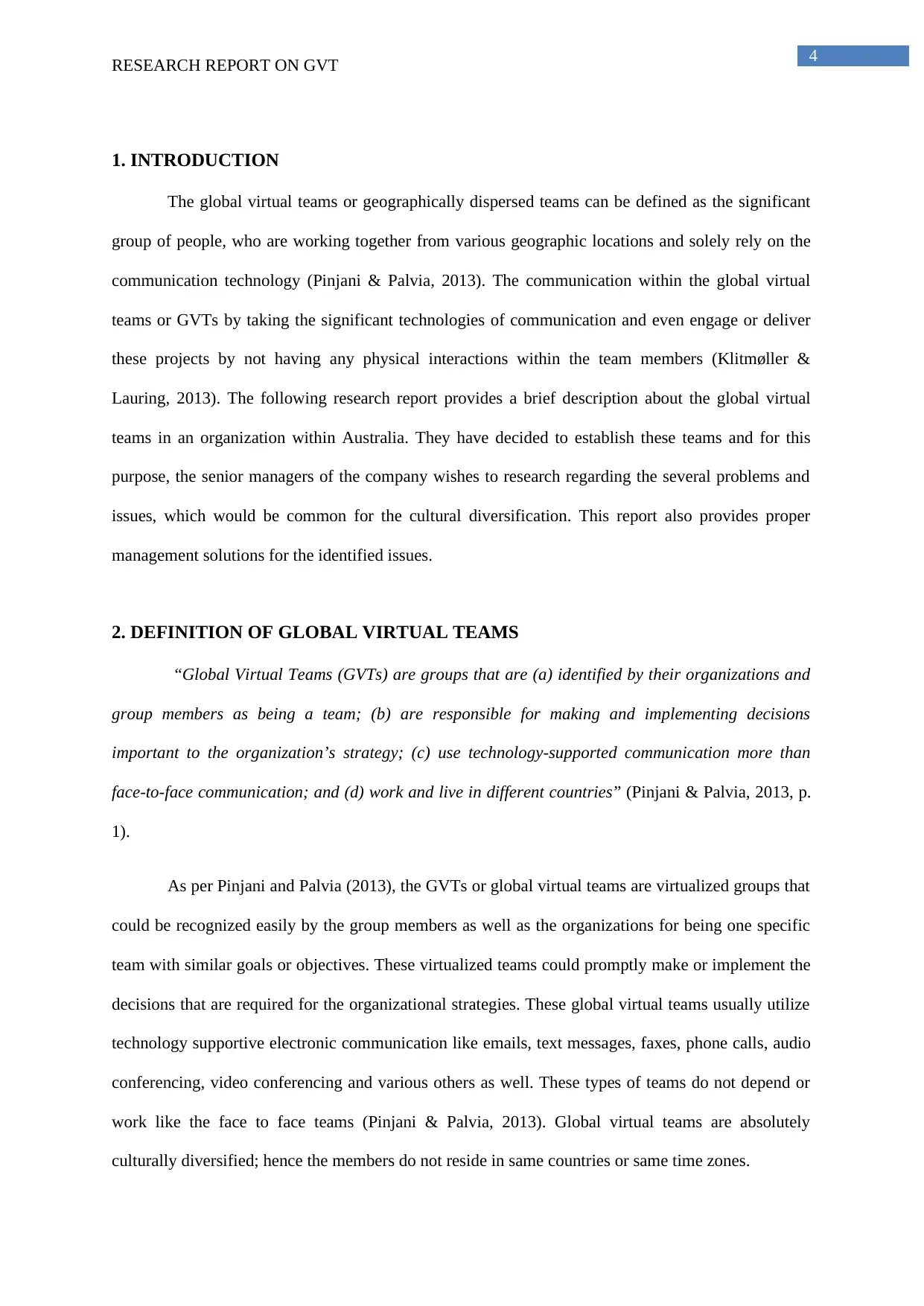
4
RESEARCH REPORT ON GVT
1. INTRODUCTION
The global virtual teams or geographically dispersed teams can be defined as the significant
group of people, who are working together from various geographic locations and solely rely on the
communication technology (Pinjani & Palvia, 2013). The communication within the global virtual
teams or GVTs by taking the significant technologies of communication and even engage or deliver
these projects by not having any physical interactions within the team members (Klitmøller &
Lauring, 2013). The following research report provides a brief description about the global virtual
teams in an organization within Australia. They have decided to establish these teams and for this
purpose, the senior managers of the company wishes to research regarding the several problems and
issues, which would be common for the cultural diversification. This report also provides proper
management solutions for the identified issues.
2. DEFINITION OF GLOBAL VIRTUAL TEAMS
“Global Virtual Teams (GVTs) are groups that are (a) identified by their organizations and
group members as being a team; (b) are responsible for making and implementing decisions
important to the organization’s strategy; (c) use technology-supported communication more than
face-to-face communication; and (d) work and live in different countries” (Pinjani & Palvia, 2013, p.
1).
As per Pinjani and Palvia (2013), the GVTs or global virtual teams are virtualized groups that
could be recognized easily by the group members as well as the organizations for being one specific
team with similar goals or objectives. These virtualized teams could promptly make or implement the
decisions that are required for the organizational strategies. These global virtual teams usually utilize
technology supportive electronic communication like emails, text messages, faxes, phone calls, audio
conferencing, video conferencing and various others as well. These types of teams do not depend or
work like the face to face teams (Pinjani & Palvia, 2013). Global virtual teams are absolutely
culturally diversified; hence the members do not reside in same countries or same time zones.
RESEARCH REPORT ON GVT
1. INTRODUCTION
The global virtual teams or geographically dispersed teams can be defined as the significant
group of people, who are working together from various geographic locations and solely rely on the
communication technology (Pinjani & Palvia, 2013). The communication within the global virtual
teams or GVTs by taking the significant technologies of communication and even engage or deliver
these projects by not having any physical interactions within the team members (Klitmøller &
Lauring, 2013). The following research report provides a brief description about the global virtual
teams in an organization within Australia. They have decided to establish these teams and for this
purpose, the senior managers of the company wishes to research regarding the several problems and
issues, which would be common for the cultural diversification. This report also provides proper
management solutions for the identified issues.
2. DEFINITION OF GLOBAL VIRTUAL TEAMS
“Global Virtual Teams (GVTs) are groups that are (a) identified by their organizations and
group members as being a team; (b) are responsible for making and implementing decisions
important to the organization’s strategy; (c) use technology-supported communication more than
face-to-face communication; and (d) work and live in different countries” (Pinjani & Palvia, 2013, p.
1).
As per Pinjani and Palvia (2013), the GVTs or global virtual teams are virtualized groups that
could be recognized easily by the group members as well as the organizations for being one specific
team with similar goals or objectives. These virtualized teams could promptly make or implement the
decisions that are required for the organizational strategies. These global virtual teams usually utilize
technology supportive electronic communication like emails, text messages, faxes, phone calls, audio
conferencing, video conferencing and various others as well. These types of teams do not depend or
work like the face to face teams (Pinjani & Palvia, 2013). Global virtual teams are absolutely
culturally diversified; hence the members do not reside in same countries or same time zones.
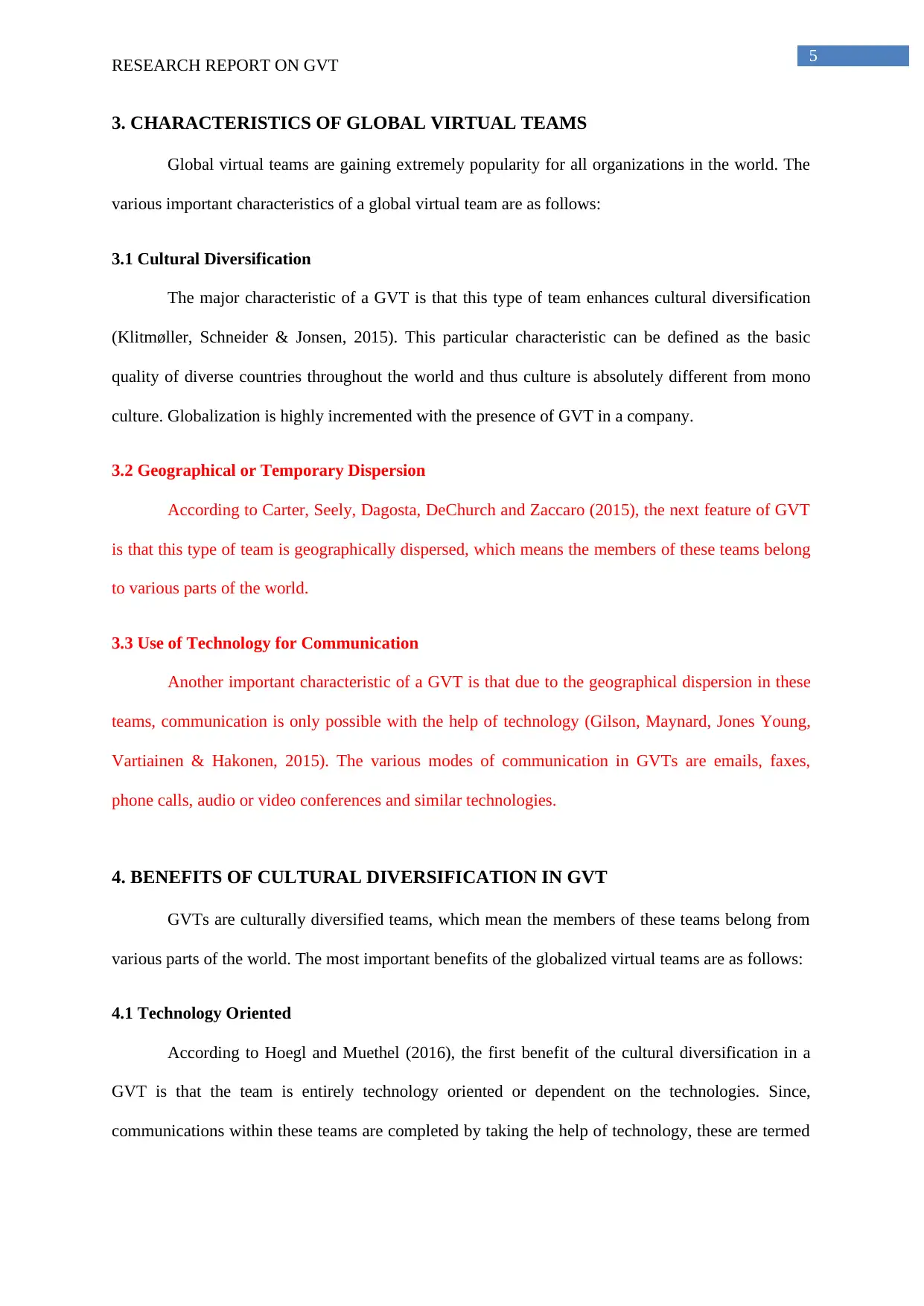
5
RESEARCH REPORT ON GVT
3. CHARACTERISTICS OF GLOBAL VIRTUAL TEAMS
Global virtual teams are gaining extremely popularity for all organizations in the world. The
various important characteristics of a global virtual team are as follows:
3.1 Cultural Diversification
The major characteristic of a GVT is that this type of team enhances cultural diversification
(Klitmøller, Schneider & Jonsen, 2015). This particular characteristic can be defined as the basic
quality of diverse countries throughout the world and thus culture is absolutely different from mono
culture. Globalization is highly incremented with the presence of GVT in a company.
3.2 Geographical or Temporary Dispersion
According to Carter, Seely, Dagosta, DeChurch and Zaccaro (2015), the next feature of GVT
is that this type of team is geographically dispersed, which means the members of these teams belong
to various parts of the world.
3.3 Use of Technology for Communication
Another important characteristic of a GVT is that due to the geographical dispersion in these
teams, communication is only possible with the help of technology (Gilson, Maynard, Jones Young,
Vartiainen & Hakonen, 2015). The various modes of communication in GVTs are emails, faxes,
phone calls, audio or video conferences and similar technologies.
4. BENEFITS OF CULTURAL DIVERSIFICATION IN GVT
GVTs are culturally diversified teams, which mean the members of these teams belong from
various parts of the world. The most important benefits of the globalized virtual teams are as follows:
4.1 Technology Oriented
According to Hoegl and Muethel (2016), the first benefit of the cultural diversification in a
GVT is that the team is entirely technology oriented or dependent on the technologies. Since,
communications within these teams are completed by taking the help of technology, these are termed
RESEARCH REPORT ON GVT
3. CHARACTERISTICS OF GLOBAL VIRTUAL TEAMS
Global virtual teams are gaining extremely popularity for all organizations in the world. The
various important characteristics of a global virtual team are as follows:
3.1 Cultural Diversification
The major characteristic of a GVT is that this type of team enhances cultural diversification
(Klitmøller, Schneider & Jonsen, 2015). This particular characteristic can be defined as the basic
quality of diverse countries throughout the world and thus culture is absolutely different from mono
culture. Globalization is highly incremented with the presence of GVT in a company.
3.2 Geographical or Temporary Dispersion
According to Carter, Seely, Dagosta, DeChurch and Zaccaro (2015), the next feature of GVT
is that this type of team is geographically dispersed, which means the members of these teams belong
to various parts of the world.
3.3 Use of Technology for Communication
Another important characteristic of a GVT is that due to the geographical dispersion in these
teams, communication is only possible with the help of technology (Gilson, Maynard, Jones Young,
Vartiainen & Hakonen, 2015). The various modes of communication in GVTs are emails, faxes,
phone calls, audio or video conferences and similar technologies.
4. BENEFITS OF CULTURAL DIVERSIFICATION IN GVT
GVTs are culturally diversified teams, which mean the members of these teams belong from
various parts of the world. The most important benefits of the globalized virtual teams are as follows:
4.1 Technology Oriented
According to Hoegl and Muethel (2016), the first benefit of the cultural diversification in a
GVT is that the team is entirely technology oriented or dependent on the technologies. Since,
communications within these teams are completed by taking the help of technology, these are termed
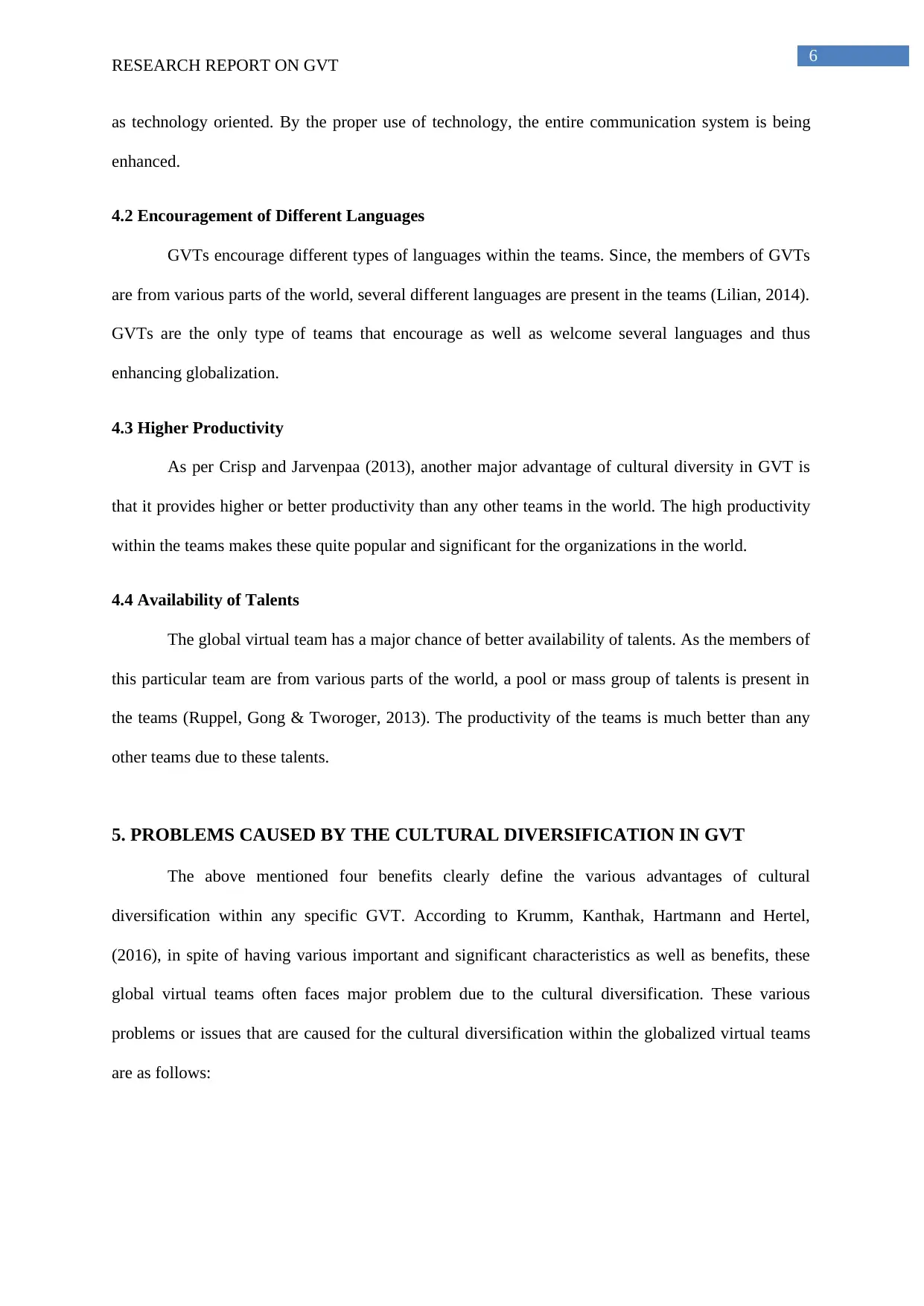
6
RESEARCH REPORT ON GVT
as technology oriented. By the proper use of technology, the entire communication system is being
enhanced.
4.2 Encouragement of Different Languages
GVTs encourage different types of languages within the teams. Since, the members of GVTs
are from various parts of the world, several different languages are present in the teams (Lilian, 2014).
GVTs are the only type of teams that encourage as well as welcome several languages and thus
enhancing globalization.
4.3 Higher Productivity
As per Crisp and Jarvenpaa (2013), another major advantage of cultural diversity in GVT is
that it provides higher or better productivity than any other teams in the world. The high productivity
within the teams makes these quite popular and significant for the organizations in the world.
4.4 Availability of Talents
The global virtual team has a major chance of better availability of talents. As the members of
this particular team are from various parts of the world, a pool or mass group of talents is present in
the teams (Ruppel, Gong & Tworoger, 2013). The productivity of the teams is much better than any
other teams due to these talents.
5. PROBLEMS CAUSED BY THE CULTURAL DIVERSIFICATION IN GVT
The above mentioned four benefits clearly define the various advantages of cultural
diversification within any specific GVT. According to Krumm, Kanthak, Hartmann and Hertel,
(2016), in spite of having various important and significant characteristics as well as benefits, these
global virtual teams often faces major problem due to the cultural diversification. These various
problems or issues that are caused for the cultural diversification within the globalized virtual teams
are as follows:
RESEARCH REPORT ON GVT
as technology oriented. By the proper use of technology, the entire communication system is being
enhanced.
4.2 Encouragement of Different Languages
GVTs encourage different types of languages within the teams. Since, the members of GVTs
are from various parts of the world, several different languages are present in the teams (Lilian, 2014).
GVTs are the only type of teams that encourage as well as welcome several languages and thus
enhancing globalization.
4.3 Higher Productivity
As per Crisp and Jarvenpaa (2013), another major advantage of cultural diversity in GVT is
that it provides higher or better productivity than any other teams in the world. The high productivity
within the teams makes these quite popular and significant for the organizations in the world.
4.4 Availability of Talents
The global virtual team has a major chance of better availability of talents. As the members of
this particular team are from various parts of the world, a pool or mass group of talents is present in
the teams (Ruppel, Gong & Tworoger, 2013). The productivity of the teams is much better than any
other teams due to these talents.
5. PROBLEMS CAUSED BY THE CULTURAL DIVERSIFICATION IN GVT
The above mentioned four benefits clearly define the various advantages of cultural
diversification within any specific GVT. According to Krumm, Kanthak, Hartmann and Hertel,
(2016), in spite of having various important and significant characteristics as well as benefits, these
global virtual teams often faces major problem due to the cultural diversification. These various
problems or issues that are caused for the cultural diversification within the globalized virtual teams
are as follows:
Paraphrase This Document
Need a fresh take? Get an instant paraphrase of this document with our AI Paraphraser
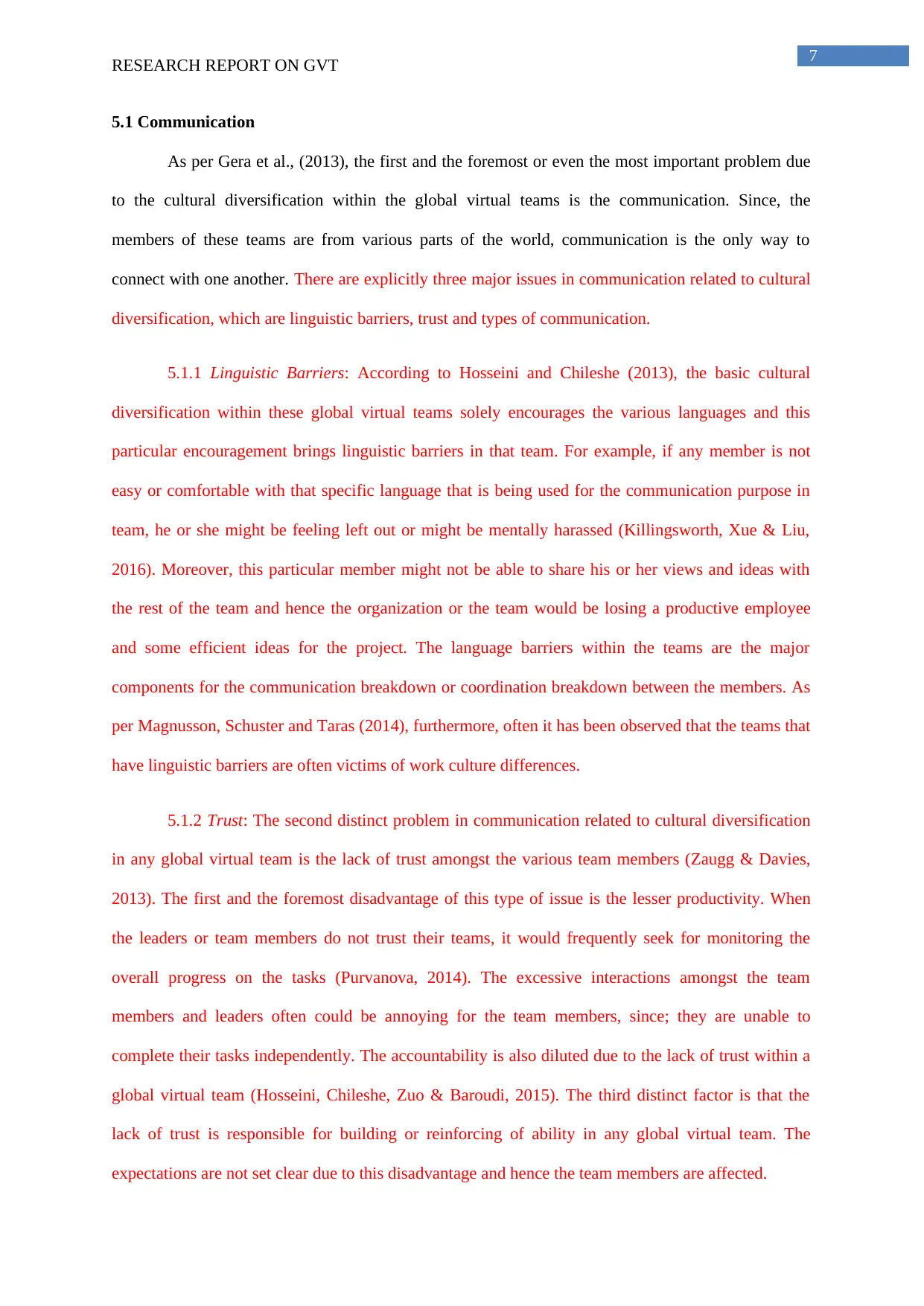
7
RESEARCH REPORT ON GVT
5.1 Communication
As per Gera et al., (2013), the first and the foremost or even the most important problem due
to the cultural diversification within the global virtual teams is the communication. Since, the
members of these teams are from various parts of the world, communication is the only way to
connect with one another. There are explicitly three major issues in communication related to cultural
diversification, which are linguistic barriers, trust and types of communication.
5.1.1 Linguistic Barriers: According to Hosseini and Chileshe (2013), the basic cultural
diversification within these global virtual teams solely encourages the various languages and this
particular encouragement brings linguistic barriers in that team. For example, if any member is not
easy or comfortable with that specific language that is being used for the communication purpose in
team, he or she might be feeling left out or might be mentally harassed (Killingsworth, Xue & Liu,
2016). Moreover, this particular member might not be able to share his or her views and ideas with
the rest of the team and hence the organization or the team would be losing a productive employee
and some efficient ideas for the project. The language barriers within the teams are the major
components for the communication breakdown or coordination breakdown between the members. As
per Magnusson, Schuster and Taras (2014), furthermore, often it has been observed that the teams that
have linguistic barriers are often victims of work culture differences.
5.1.2 Trust: The second distinct problem in communication related to cultural diversification
in any global virtual team is the lack of trust amongst the various team members (Zaugg & Davies,
2013). The first and the foremost disadvantage of this type of issue is the lesser productivity. When
the leaders or team members do not trust their teams, it would frequently seek for monitoring the
overall progress on the tasks (Purvanova, 2014). The excessive interactions amongst the team
members and leaders often could be annoying for the team members, since; they are unable to
complete their tasks independently. The accountability is also diluted due to the lack of trust within a
global virtual team (Hosseini, Chileshe, Zuo & Baroudi, 2015). The third distinct factor is that the
lack of trust is responsible for building or reinforcing of ability in any global virtual team. The
expectations are not set clear due to this disadvantage and hence the team members are affected.
RESEARCH REPORT ON GVT
5.1 Communication
As per Gera et al., (2013), the first and the foremost or even the most important problem due
to the cultural diversification within the global virtual teams is the communication. Since, the
members of these teams are from various parts of the world, communication is the only way to
connect with one another. There are explicitly three major issues in communication related to cultural
diversification, which are linguistic barriers, trust and types of communication.
5.1.1 Linguistic Barriers: According to Hosseini and Chileshe (2013), the basic cultural
diversification within these global virtual teams solely encourages the various languages and this
particular encouragement brings linguistic barriers in that team. For example, if any member is not
easy or comfortable with that specific language that is being used for the communication purpose in
team, he or she might be feeling left out or might be mentally harassed (Killingsworth, Xue & Liu,
2016). Moreover, this particular member might not be able to share his or her views and ideas with
the rest of the team and hence the organization or the team would be losing a productive employee
and some efficient ideas for the project. The language barriers within the teams are the major
components for the communication breakdown or coordination breakdown between the members. As
per Magnusson, Schuster and Taras (2014), furthermore, often it has been observed that the teams that
have linguistic barriers are often victims of work culture differences.
5.1.2 Trust: The second distinct problem in communication related to cultural diversification
in any global virtual team is the lack of trust amongst the various team members (Zaugg & Davies,
2013). The first and the foremost disadvantage of this type of issue is the lesser productivity. When
the leaders or team members do not trust their teams, it would frequently seek for monitoring the
overall progress on the tasks (Purvanova, 2014). The excessive interactions amongst the team
members and leaders often could be annoying for the team members, since; they are unable to
complete their tasks independently. The accountability is also diluted due to the lack of trust within a
global virtual team (Hosseini, Chileshe, Zuo & Baroudi, 2015). The third distinct factor is that the
lack of trust is responsible for building or reinforcing of ability in any global virtual team. The
expectations are not set clear due to this disadvantage and hence the team members are affected.
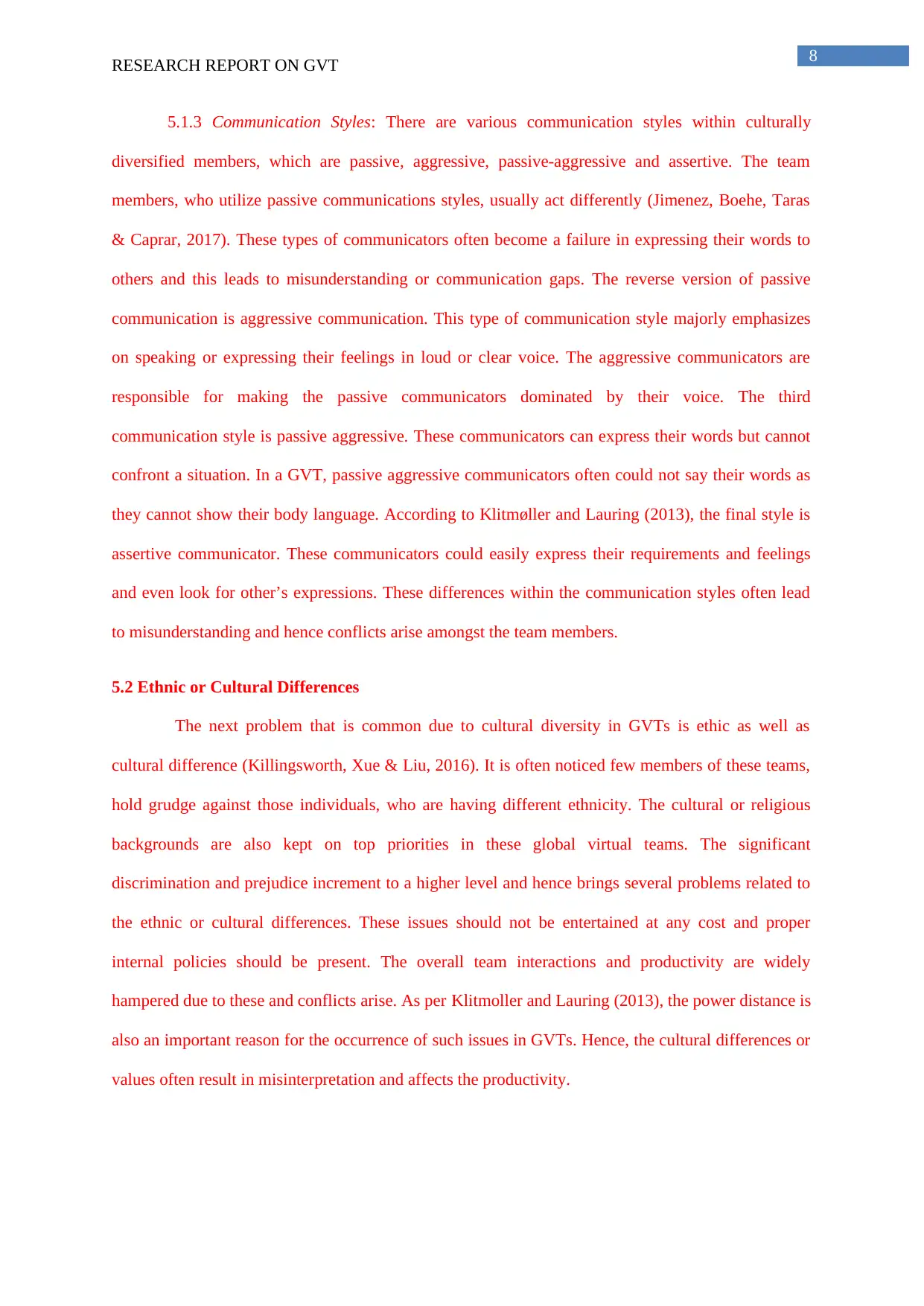
8
RESEARCH REPORT ON GVT
5.1.3 Communication Styles: There are various communication styles within culturally
diversified members, which are passive, aggressive, passive-aggressive and assertive. The team
members, who utilize passive communications styles, usually act differently (Jimenez, Boehe, Taras
& Caprar, 2017). These types of communicators often become a failure in expressing their words to
others and this leads to misunderstanding or communication gaps. The reverse version of passive
communication is aggressive communication. This type of communication style majorly emphasizes
on speaking or expressing their feelings in loud or clear voice. The aggressive communicators are
responsible for making the passive communicators dominated by their voice. The third
communication style is passive aggressive. These communicators can express their words but cannot
confront a situation. In a GVT, passive aggressive communicators often could not say their words as
they cannot show their body language. According to Klitmøller and Lauring (2013), the final style is
assertive communicator. These communicators could easily express their requirements and feelings
and even look for other’s expressions. These differences within the communication styles often lead
to misunderstanding and hence conflicts arise amongst the team members.
5.2 Ethnic or Cultural Differences
The next problem that is common due to cultural diversity in GVTs is ethic as well as
cultural difference (Killingsworth, Xue & Liu, 2016). It is often noticed few members of these teams,
hold grudge against those individuals, who are having different ethnicity. The cultural or religious
backgrounds are also kept on top priorities in these global virtual teams. The significant
discrimination and prejudice increment to a higher level and hence brings several problems related to
the ethnic or cultural differences. These issues should not be entertained at any cost and proper
internal policies should be present. The overall team interactions and productivity are widely
hampered due to these and conflicts arise. As per Klitmoller and Lauring (2013), the power distance is
also an important reason for the occurrence of such issues in GVTs. Hence, the cultural differences or
values often result in misinterpretation and affects the productivity.
RESEARCH REPORT ON GVT
5.1.3 Communication Styles: There are various communication styles within culturally
diversified members, which are passive, aggressive, passive-aggressive and assertive. The team
members, who utilize passive communications styles, usually act differently (Jimenez, Boehe, Taras
& Caprar, 2017). These types of communicators often become a failure in expressing their words to
others and this leads to misunderstanding or communication gaps. The reverse version of passive
communication is aggressive communication. This type of communication style majorly emphasizes
on speaking or expressing their feelings in loud or clear voice. The aggressive communicators are
responsible for making the passive communicators dominated by their voice. The third
communication style is passive aggressive. These communicators can express their words but cannot
confront a situation. In a GVT, passive aggressive communicators often could not say their words as
they cannot show their body language. According to Klitmøller and Lauring (2013), the final style is
assertive communicator. These communicators could easily express their requirements and feelings
and even look for other’s expressions. These differences within the communication styles often lead
to misunderstanding and hence conflicts arise amongst the team members.
5.2 Ethnic or Cultural Differences
The next problem that is common due to cultural diversity in GVTs is ethic as well as
cultural difference (Killingsworth, Xue & Liu, 2016). It is often noticed few members of these teams,
hold grudge against those individuals, who are having different ethnicity. The cultural or religious
backgrounds are also kept on top priorities in these global virtual teams. The significant
discrimination and prejudice increment to a higher level and hence brings several problems related to
the ethnic or cultural differences. These issues should not be entertained at any cost and proper
internal policies should be present. The overall team interactions and productivity are widely
hampered due to these and conflicts arise. As per Klitmoller and Lauring (2013), the power distance is
also an important reason for the occurrence of such issues in GVTs. Hence, the cultural differences or
values often result in misinterpretation and affects the productivity.
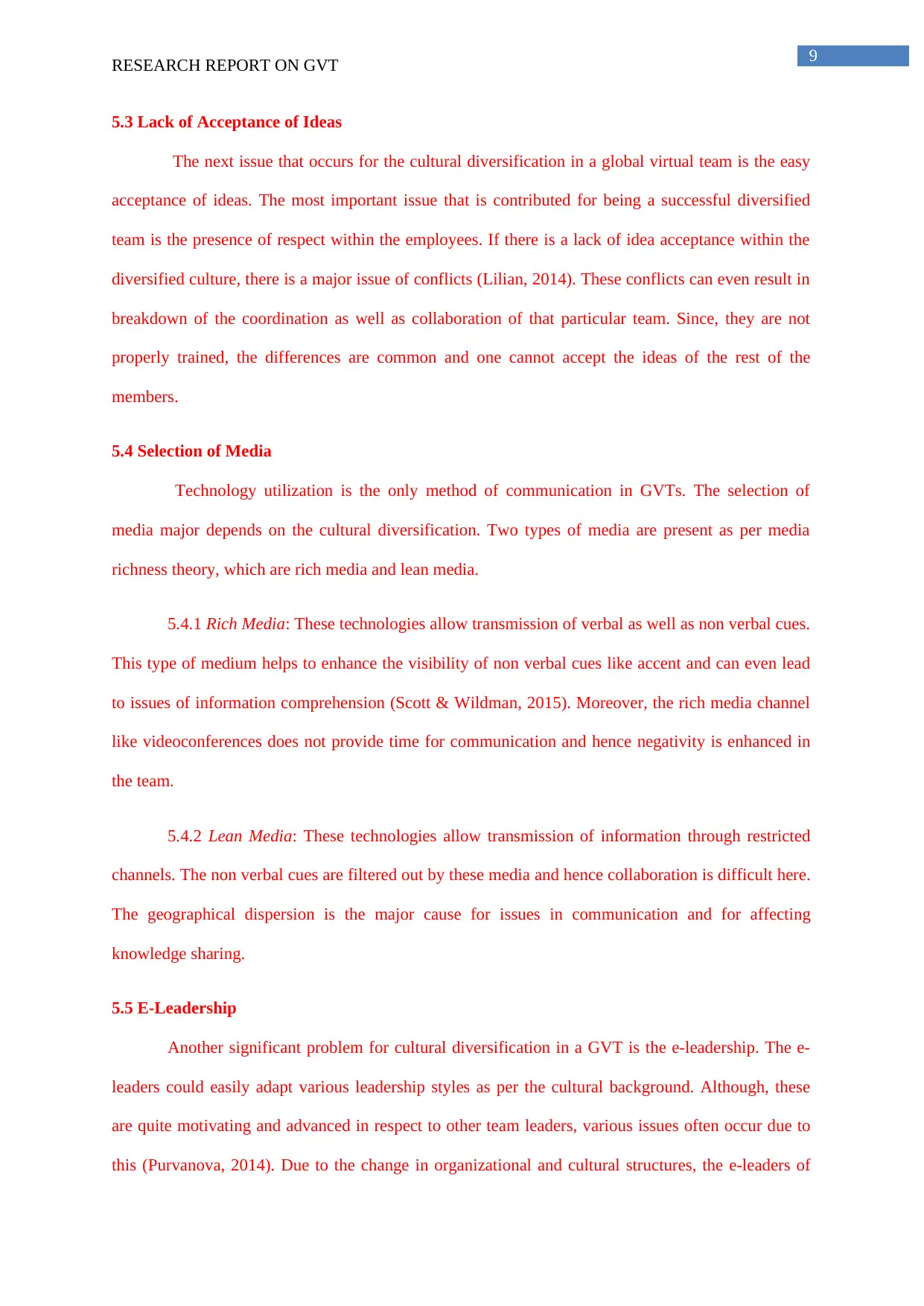
9
RESEARCH REPORT ON GVT
5.3 Lack of Acceptance of Ideas
The next issue that occurs for the cultural diversification in a global virtual team is the easy
acceptance of ideas. The most important issue that is contributed for being a successful diversified
team is the presence of respect within the employees. If there is a lack of idea acceptance within the
diversified culture, there is a major issue of conflicts (Lilian, 2014). These conflicts can even result in
breakdown of the coordination as well as collaboration of that particular team. Since, they are not
properly trained, the differences are common and one cannot accept the ideas of the rest of the
members.
5.4 Selection of Media
Technology utilization is the only method of communication in GVTs. The selection of
media major depends on the cultural diversification. Two types of media are present as per media
richness theory, which are rich media and lean media.
5.4.1 Rich Media: These technologies allow transmission of verbal as well as non verbal cues.
This type of medium helps to enhance the visibility of non verbal cues like accent and can even lead
to issues of information comprehension (Scott & Wildman, 2015). Moreover, the rich media channel
like videoconferences does not provide time for communication and hence negativity is enhanced in
the team.
5.4.2 Lean Media: These technologies allow transmission of information through restricted
channels. The non verbal cues are filtered out by these media and hence collaboration is difficult here.
The geographical dispersion is the major cause for issues in communication and for affecting
knowledge sharing.
5.5 E-Leadership
Another significant problem for cultural diversification in a GVT is the e-leadership. The e-
leaders could easily adapt various leadership styles as per the cultural background. Although, these
are quite motivating and advanced in respect to other team leaders, various issues often occur due to
this (Purvanova, 2014). Due to the change in organizational and cultural structures, the e-leaders of
RESEARCH REPORT ON GVT
5.3 Lack of Acceptance of Ideas
The next issue that occurs for the cultural diversification in a global virtual team is the easy
acceptance of ideas. The most important issue that is contributed for being a successful diversified
team is the presence of respect within the employees. If there is a lack of idea acceptance within the
diversified culture, there is a major issue of conflicts (Lilian, 2014). These conflicts can even result in
breakdown of the coordination as well as collaboration of that particular team. Since, they are not
properly trained, the differences are common and one cannot accept the ideas of the rest of the
members.
5.4 Selection of Media
Technology utilization is the only method of communication in GVTs. The selection of
media major depends on the cultural diversification. Two types of media are present as per media
richness theory, which are rich media and lean media.
5.4.1 Rich Media: These technologies allow transmission of verbal as well as non verbal cues.
This type of medium helps to enhance the visibility of non verbal cues like accent and can even lead
to issues of information comprehension (Scott & Wildman, 2015). Moreover, the rich media channel
like videoconferences does not provide time for communication and hence negativity is enhanced in
the team.
5.4.2 Lean Media: These technologies allow transmission of information through restricted
channels. The non verbal cues are filtered out by these media and hence collaboration is difficult here.
The geographical dispersion is the major cause for issues in communication and for affecting
knowledge sharing.
5.5 E-Leadership
Another significant problem for cultural diversification in a GVT is the e-leadership. The e-
leaders could easily adapt various leadership styles as per the cultural background. Although, these
are quite motivating and advanced in respect to other team leaders, various issues often occur due to
this (Purvanova, 2014). Due to the change in organizational and cultural structures, the e-leaders of
Secure Best Marks with AI Grader
Need help grading? Try our AI Grader for instant feedback on your assignments.
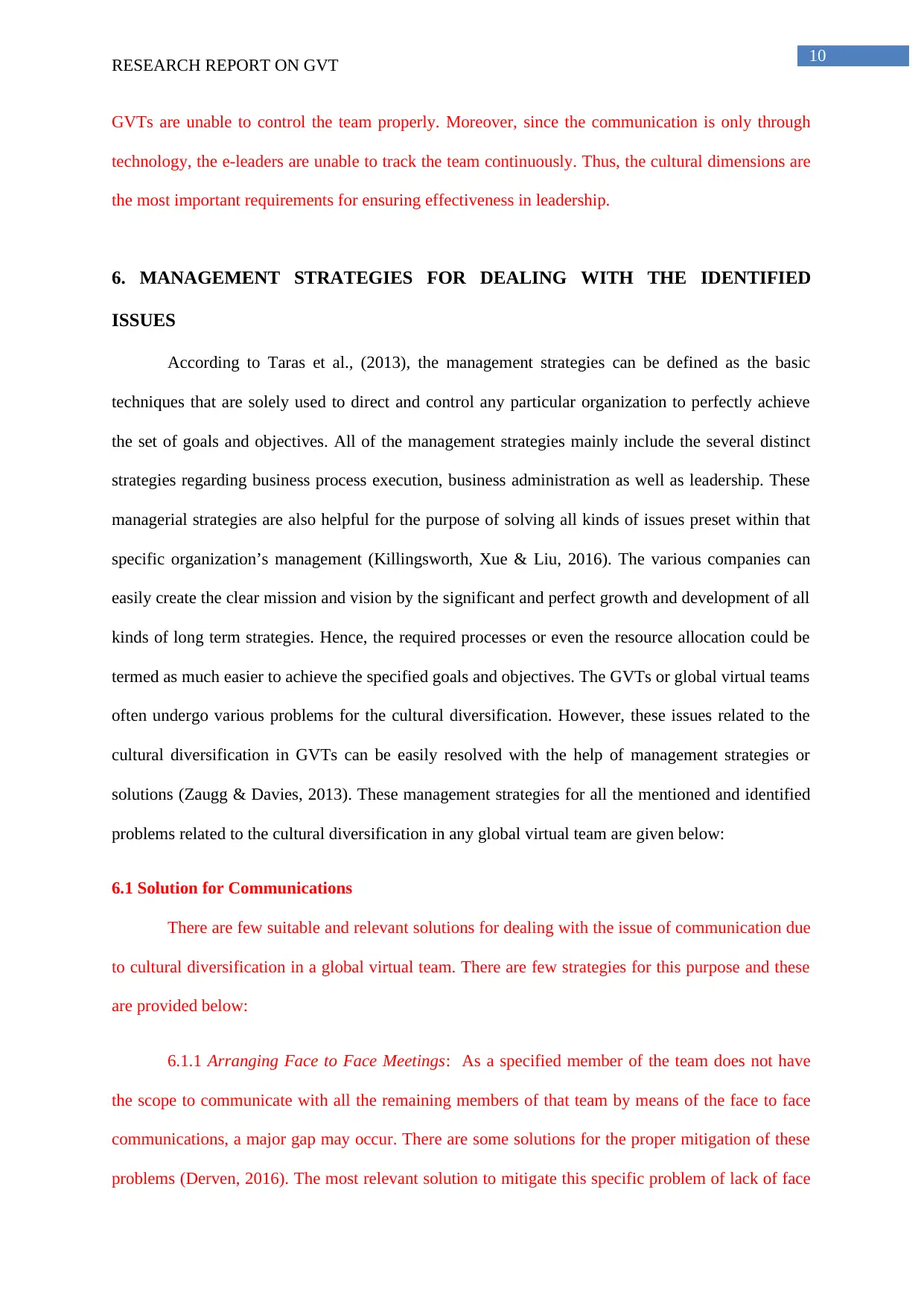
10
RESEARCH REPORT ON GVT
GVTs are unable to control the team properly. Moreover, since the communication is only through
technology, the e-leaders are unable to track the team continuously. Thus, the cultural dimensions are
the most important requirements for ensuring effectiveness in leadership.
6. MANAGEMENT STRATEGIES FOR DEALING WITH THE IDENTIFIED
ISSUES
According to Taras et al., (2013), the management strategies can be defined as the basic
techniques that are solely used to direct and control any particular organization to perfectly achieve
the set of goals and objectives. All of the management strategies mainly include the several distinct
strategies regarding business process execution, business administration as well as leadership. These
managerial strategies are also helpful for the purpose of solving all kinds of issues preset within that
specific organization’s management (Killingsworth, Xue & Liu, 2016). The various companies can
easily create the clear mission and vision by the significant and perfect growth and development of all
kinds of long term strategies. Hence, the required processes or even the resource allocation could be
termed as much easier to achieve the specified goals and objectives. The GVTs or global virtual teams
often undergo various problems for the cultural diversification. However, these issues related to the
cultural diversification in GVTs can be easily resolved with the help of management strategies or
solutions (Zaugg & Davies, 2013). These management strategies for all the mentioned and identified
problems related to the cultural diversification in any global virtual team are given below:
6.1 Solution for Communications
There are few suitable and relevant solutions for dealing with the issue of communication due
to cultural diversification in a global virtual team. There are few strategies for this purpose and these
are provided below:
6.1.1 Arranging Face to Face Meetings: As a specified member of the team does not have
the scope to communicate with all the remaining members of that team by means of the face to face
communications, a major gap may occur. There are some solutions for the proper mitigation of these
problems (Derven, 2016). The most relevant solution to mitigate this specific problem of lack of face
RESEARCH REPORT ON GVT
GVTs are unable to control the team properly. Moreover, since the communication is only through
technology, the e-leaders are unable to track the team continuously. Thus, the cultural dimensions are
the most important requirements for ensuring effectiveness in leadership.
6. MANAGEMENT STRATEGIES FOR DEALING WITH THE IDENTIFIED
ISSUES
According to Taras et al., (2013), the management strategies can be defined as the basic
techniques that are solely used to direct and control any particular organization to perfectly achieve
the set of goals and objectives. All of the management strategies mainly include the several distinct
strategies regarding business process execution, business administration as well as leadership. These
managerial strategies are also helpful for the purpose of solving all kinds of issues preset within that
specific organization’s management (Killingsworth, Xue & Liu, 2016). The various companies can
easily create the clear mission and vision by the significant and perfect growth and development of all
kinds of long term strategies. Hence, the required processes or even the resource allocation could be
termed as much easier to achieve the specified goals and objectives. The GVTs or global virtual teams
often undergo various problems for the cultural diversification. However, these issues related to the
cultural diversification in GVTs can be easily resolved with the help of management strategies or
solutions (Zaugg & Davies, 2013). These management strategies for all the mentioned and identified
problems related to the cultural diversification in any global virtual team are given below:
6.1 Solution for Communications
There are few suitable and relevant solutions for dealing with the issue of communication due
to cultural diversification in a global virtual team. There are few strategies for this purpose and these
are provided below:
6.1.1 Arranging Face to Face Meetings: As a specified member of the team does not have
the scope to communicate with all the remaining members of that team by means of the face to face
communications, a major gap may occur. There are some solutions for the proper mitigation of these
problems (Derven, 2016). The most relevant solution to mitigate this specific problem of lack of face
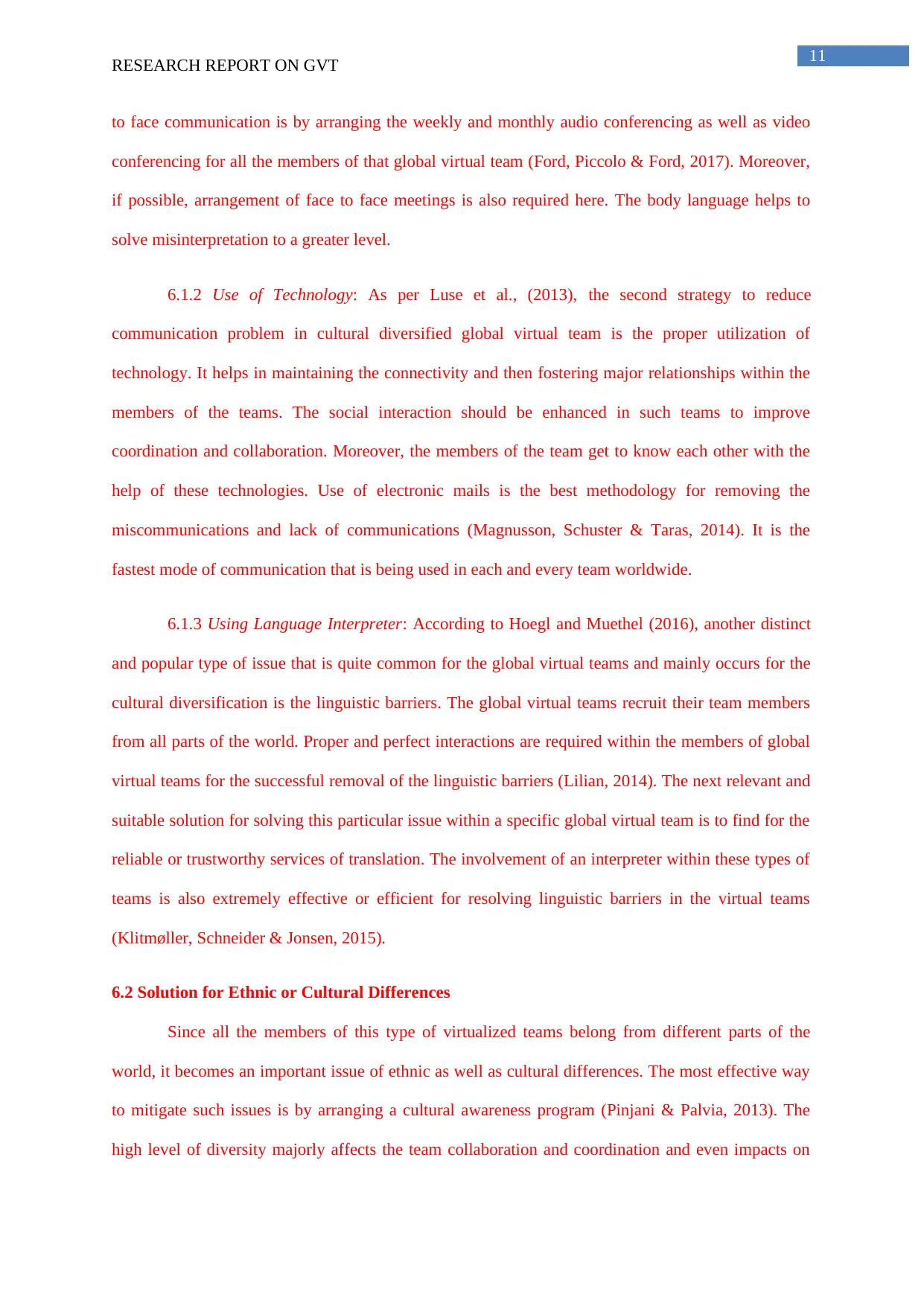
11
RESEARCH REPORT ON GVT
to face communication is by arranging the weekly and monthly audio conferencing as well as video
conferencing for all the members of that global virtual team (Ford, Piccolo & Ford, 2017). Moreover,
if possible, arrangement of face to face meetings is also required here. The body language helps to
solve misinterpretation to a greater level.
6.1.2 Use of Technology: As per Luse et al., (2013), the second strategy to reduce
communication problem in cultural diversified global virtual team is the proper utilization of
technology. It helps in maintaining the connectivity and then fostering major relationships within the
members of the teams. The social interaction should be enhanced in such teams to improve
coordination and collaboration. Moreover, the members of the team get to know each other with the
help of these technologies. Use of electronic mails is the best methodology for removing the
miscommunications and lack of communications (Magnusson, Schuster & Taras, 2014). It is the
fastest mode of communication that is being used in each and every team worldwide.
6.1.3 Using Language Interpreter: According to Hoegl and Muethel (2016), another distinct
and popular type of issue that is quite common for the global virtual teams and mainly occurs for the
cultural diversification is the linguistic barriers. The global virtual teams recruit their team members
from all parts of the world. Proper and perfect interactions are required within the members of global
virtual teams for the successful removal of the linguistic barriers (Lilian, 2014). The next relevant and
suitable solution for solving this particular issue within a specific global virtual team is to find for the
reliable or trustworthy services of translation. The involvement of an interpreter within these types of
teams is also extremely effective or efficient for resolving linguistic barriers in the virtual teams
(Klitmøller, Schneider & Jonsen, 2015).
6.2 Solution for Ethnic or Cultural Differences
Since all the members of this type of virtualized teams belong from different parts of the
world, it becomes an important issue of ethnic as well as cultural differences. The most effective way
to mitigate such issues is by arranging a cultural awareness program (Pinjani & Palvia, 2013). The
high level of diversity majorly affects the team collaboration and coordination and even impacts on
RESEARCH REPORT ON GVT
to face communication is by arranging the weekly and monthly audio conferencing as well as video
conferencing for all the members of that global virtual team (Ford, Piccolo & Ford, 2017). Moreover,
if possible, arrangement of face to face meetings is also required here. The body language helps to
solve misinterpretation to a greater level.
6.1.2 Use of Technology: As per Luse et al., (2013), the second strategy to reduce
communication problem in cultural diversified global virtual team is the proper utilization of
technology. It helps in maintaining the connectivity and then fostering major relationships within the
members of the teams. The social interaction should be enhanced in such teams to improve
coordination and collaboration. Moreover, the members of the team get to know each other with the
help of these technologies. Use of electronic mails is the best methodology for removing the
miscommunications and lack of communications (Magnusson, Schuster & Taras, 2014). It is the
fastest mode of communication that is being used in each and every team worldwide.
6.1.3 Using Language Interpreter: According to Hoegl and Muethel (2016), another distinct
and popular type of issue that is quite common for the global virtual teams and mainly occurs for the
cultural diversification is the linguistic barriers. The global virtual teams recruit their team members
from all parts of the world. Proper and perfect interactions are required within the members of global
virtual teams for the successful removal of the linguistic barriers (Lilian, 2014). The next relevant and
suitable solution for solving this particular issue within a specific global virtual team is to find for the
reliable or trustworthy services of translation. The involvement of an interpreter within these types of
teams is also extremely effective or efficient for resolving linguistic barriers in the virtual teams
(Klitmøller, Schneider & Jonsen, 2015).
6.2 Solution for Ethnic or Cultural Differences
Since all the members of this type of virtualized teams belong from different parts of the
world, it becomes an important issue of ethnic as well as cultural differences. The most effective way
to mitigate such issues is by arranging a cultural awareness program (Pinjani & Palvia, 2013). The
high level of diversity majorly affects the team collaboration and coordination and even impacts on
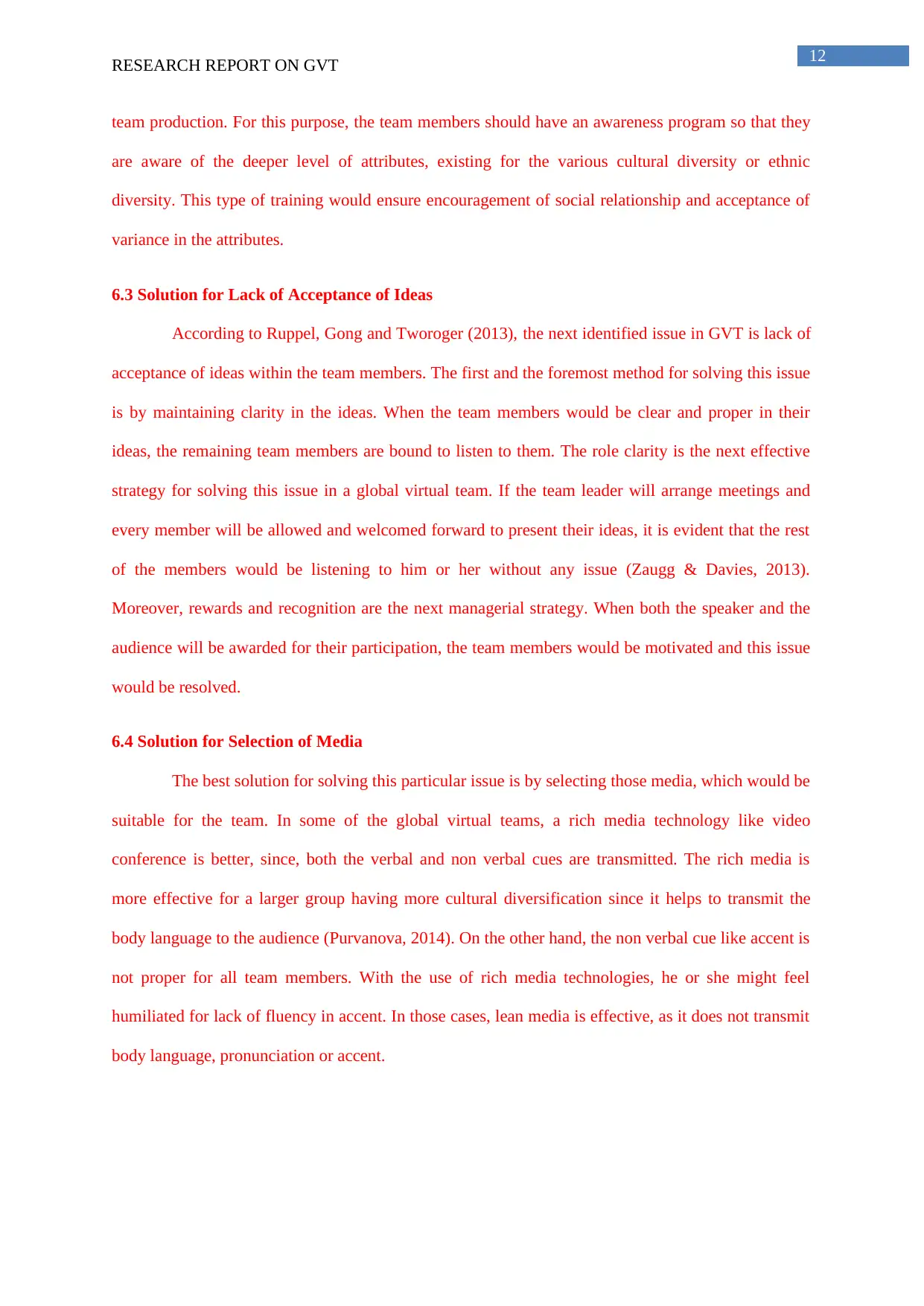
12
RESEARCH REPORT ON GVT
team production. For this purpose, the team members should have an awareness program so that they
are aware of the deeper level of attributes, existing for the various cultural diversity or ethnic
diversity. This type of training would ensure encouragement of social relationship and acceptance of
variance in the attributes.
6.3 Solution for Lack of Acceptance of Ideas
According to Ruppel, Gong and Tworoger (2013), the next identified issue in GVT is lack of
acceptance of ideas within the team members. The first and the foremost method for solving this issue
is by maintaining clarity in the ideas. When the team members would be clear and proper in their
ideas, the remaining team members are bound to listen to them. The role clarity is the next effective
strategy for solving this issue in a global virtual team. If the team leader will arrange meetings and
every member will be allowed and welcomed forward to present their ideas, it is evident that the rest
of the members would be listening to him or her without any issue (Zaugg & Davies, 2013).
Moreover, rewards and recognition are the next managerial strategy. When both the speaker and the
audience will be awarded for their participation, the team members would be motivated and this issue
would be resolved.
6.4 Solution for Selection of Media
The best solution for solving this particular issue is by selecting those media, which would be
suitable for the team. In some of the global virtual teams, a rich media technology like video
conference is better, since, both the verbal and non verbal cues are transmitted. The rich media is
more effective for a larger group having more cultural diversification since it helps to transmit the
body language to the audience (Purvanova, 2014). On the other hand, the non verbal cue like accent is
not proper for all team members. With the use of rich media technologies, he or she might feel
humiliated for lack of fluency in accent. In those cases, lean media is effective, as it does not transmit
body language, pronunciation or accent.
RESEARCH REPORT ON GVT
team production. For this purpose, the team members should have an awareness program so that they
are aware of the deeper level of attributes, existing for the various cultural diversity or ethnic
diversity. This type of training would ensure encouragement of social relationship and acceptance of
variance in the attributes.
6.3 Solution for Lack of Acceptance of Ideas
According to Ruppel, Gong and Tworoger (2013), the next identified issue in GVT is lack of
acceptance of ideas within the team members. The first and the foremost method for solving this issue
is by maintaining clarity in the ideas. When the team members would be clear and proper in their
ideas, the remaining team members are bound to listen to them. The role clarity is the next effective
strategy for solving this issue in a global virtual team. If the team leader will arrange meetings and
every member will be allowed and welcomed forward to present their ideas, it is evident that the rest
of the members would be listening to him or her without any issue (Zaugg & Davies, 2013).
Moreover, rewards and recognition are the next managerial strategy. When both the speaker and the
audience will be awarded for their participation, the team members would be motivated and this issue
would be resolved.
6.4 Solution for Selection of Media
The best solution for solving this particular issue is by selecting those media, which would be
suitable for the team. In some of the global virtual teams, a rich media technology like video
conference is better, since, both the verbal and non verbal cues are transmitted. The rich media is
more effective for a larger group having more cultural diversification since it helps to transmit the
body language to the audience (Purvanova, 2014). On the other hand, the non verbal cue like accent is
not proper for all team members. With the use of rich media technologies, he or she might feel
humiliated for lack of fluency in accent. In those cases, lean media is effective, as it does not transmit
body language, pronunciation or accent.
Paraphrase This Document
Need a fresh take? Get an instant paraphrase of this document with our AI Paraphraser
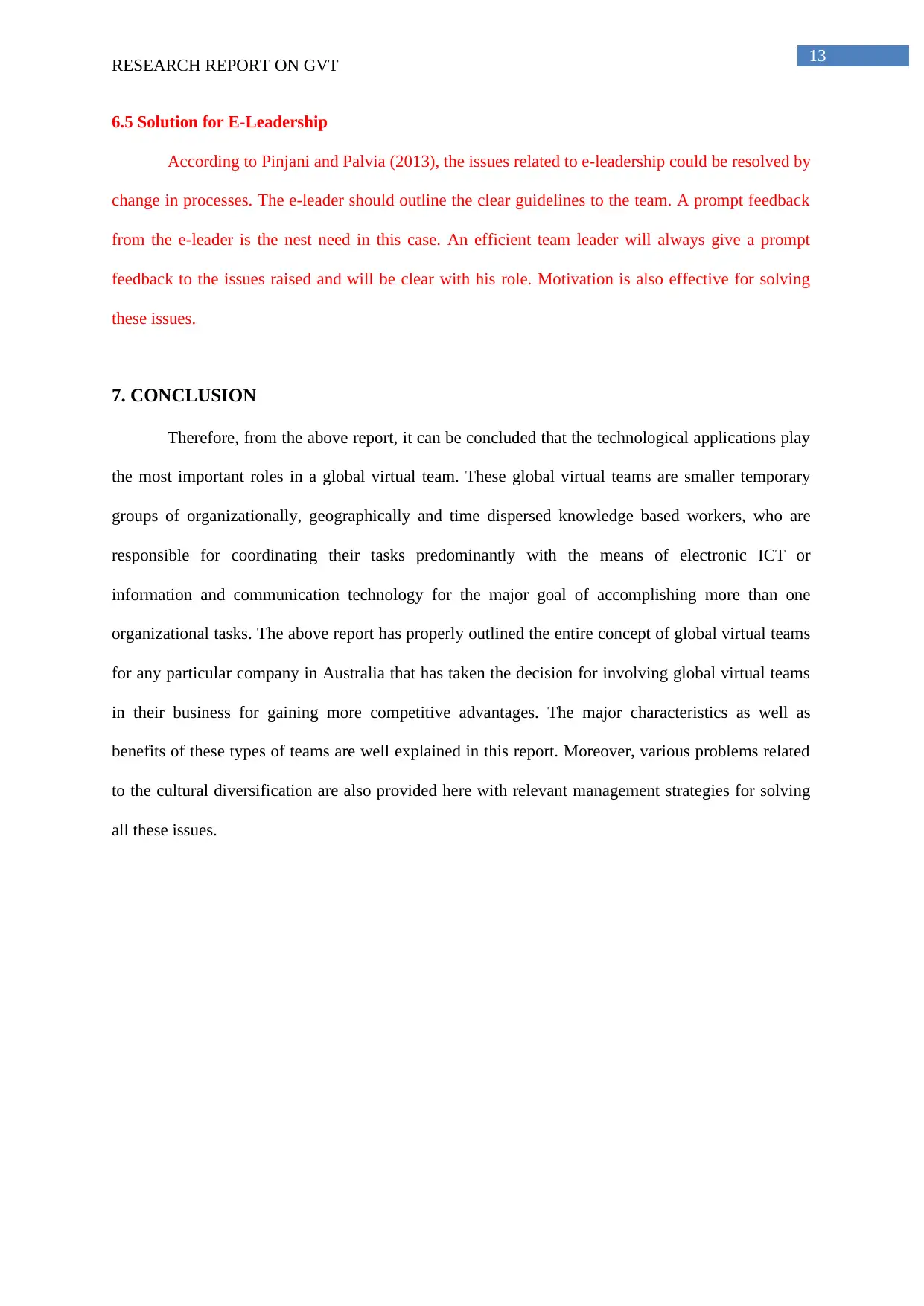
13
RESEARCH REPORT ON GVT
6.5 Solution for E-Leadership
According to Pinjani and Palvia (2013), the issues related to e-leadership could be resolved by
change in processes. The e-leader should outline the clear guidelines to the team. A prompt feedback
from the e-leader is the nest need in this case. An efficient team leader will always give a prompt
feedback to the issues raised and will be clear with his role. Motivation is also effective for solving
these issues.
7. CONCLUSION
Therefore, from the above report, it can be concluded that the technological applications play
the most important roles in a global virtual team. These global virtual teams are smaller temporary
groups of organizationally, geographically and time dispersed knowledge based workers, who are
responsible for coordinating their tasks predominantly with the means of electronic ICT or
information and communication technology for the major goal of accomplishing more than one
organizational tasks. The above report has properly outlined the entire concept of global virtual teams
for any particular company in Australia that has taken the decision for involving global virtual teams
in their business for gaining more competitive advantages. The major characteristics as well as
benefits of these types of teams are well explained in this report. Moreover, various problems related
to the cultural diversification are also provided here with relevant management strategies for solving
all these issues.
RESEARCH REPORT ON GVT
6.5 Solution for E-Leadership
According to Pinjani and Palvia (2013), the issues related to e-leadership could be resolved by
change in processes. The e-leader should outline the clear guidelines to the team. A prompt feedback
from the e-leader is the nest need in this case. An efficient team leader will always give a prompt
feedback to the issues raised and will be clear with his role. Motivation is also effective for solving
these issues.
7. CONCLUSION
Therefore, from the above report, it can be concluded that the technological applications play
the most important roles in a global virtual team. These global virtual teams are smaller temporary
groups of organizationally, geographically and time dispersed knowledge based workers, who are
responsible for coordinating their tasks predominantly with the means of electronic ICT or
information and communication technology for the major goal of accomplishing more than one
organizational tasks. The above report has properly outlined the entire concept of global virtual teams
for any particular company in Australia that has taken the decision for involving global virtual teams
in their business for gaining more competitive advantages. The major characteristics as well as
benefits of these types of teams are well explained in this report. Moreover, various problems related
to the cultural diversification are also provided here with relevant management strategies for solving
all these issues.

14
RESEARCH REPORT ON GVT
References
Carter, D. R., Seely, P. W., Dagosta, J., DeChurch, L. A., & Zaccaro, S. J. (2015). Leadership for
global virtual teams: Facilitating teamwork processes. In Leading global teams (pp. 225-252).
Springer, New York, NY. https://doi.org/10.1007/978-1-4939-2050-1_10u
Crisp, C. B., & Jarvenpaa, S. L. (2013). Swift trust in global virtual teams: Trusting beliefs and
normative actions. Journal of Personnel Psychology, 12(1), 45.
https://doi.org/10.1177%2F1548051812472370
Derven, M. (2016). Four drivers to enhance global virtual teams. Industrial and Commercial
Training, 48(1), 1-8. https://doi.org/10.1108/ICT-08-2015-0056
Ford, R. C., Piccolo, R. F., & Ford, L. R. (2017). Strategies for building effective virtual teams: Trust
is key. Business Horizons, 60(1), 25-34. http://dx.doi.org/10.1016/j.bushor.2016.08.009
Gera, S., Aneeshkumar, G., Fernandez, S., Gireeshkumar, G., Nze, I., & Eze, U. (2013). Virtual teams
versus face to face teams: A review of literature. IOSR Journal of Business and
Management, 11(2), 1-4. http://dx.doi.org/10.9790/487X-1120104
Gibson, C. B., Huang, L., Kirkman, B. L., & Shapiro, D. L. (2014). Where global and virtual meet:
The value of examining the intersection of these elements in twenty-first-century
teams. Annu. Rev. Organ. Psychol. Organ. Behav., 1(1), 217-244.
https://doi.org/10.1146/annurev-orgpsych-031413-091240
Gilson, L. L., Maynard, M. T., Jones Young, N. C., Vartiainen, M., & Hakonen, M. (2015). Virtual
teams research: 10 years, 10 themes, and 10 opportunities. Journal of Management, 41(5),
1313-1337. https://doi.org/10.1177/0149206314559946
Hoegl, M., & Muethel, M. (2016). Enabling shared leadership in virtual project teams: A
practitioners’ guide. Project Management Journal, 47(1), 7-12.
https://doi/abs/10.1002/pmj.21564
RESEARCH REPORT ON GVT
References
Carter, D. R., Seely, P. W., Dagosta, J., DeChurch, L. A., & Zaccaro, S. J. (2015). Leadership for
global virtual teams: Facilitating teamwork processes. In Leading global teams (pp. 225-252).
Springer, New York, NY. https://doi.org/10.1007/978-1-4939-2050-1_10u
Crisp, C. B., & Jarvenpaa, S. L. (2013). Swift trust in global virtual teams: Trusting beliefs and
normative actions. Journal of Personnel Psychology, 12(1), 45.
https://doi.org/10.1177%2F1548051812472370
Derven, M. (2016). Four drivers to enhance global virtual teams. Industrial and Commercial
Training, 48(1), 1-8. https://doi.org/10.1108/ICT-08-2015-0056
Ford, R. C., Piccolo, R. F., & Ford, L. R. (2017). Strategies for building effective virtual teams: Trust
is key. Business Horizons, 60(1), 25-34. http://dx.doi.org/10.1016/j.bushor.2016.08.009
Gera, S., Aneeshkumar, G., Fernandez, S., Gireeshkumar, G., Nze, I., & Eze, U. (2013). Virtual teams
versus face to face teams: A review of literature. IOSR Journal of Business and
Management, 11(2), 1-4. http://dx.doi.org/10.9790/487X-1120104
Gibson, C. B., Huang, L., Kirkman, B. L., & Shapiro, D. L. (2014). Where global and virtual meet:
The value of examining the intersection of these elements in twenty-first-century
teams. Annu. Rev. Organ. Psychol. Organ. Behav., 1(1), 217-244.
https://doi.org/10.1146/annurev-orgpsych-031413-091240
Gilson, L. L., Maynard, M. T., Jones Young, N. C., Vartiainen, M., & Hakonen, M. (2015). Virtual
teams research: 10 years, 10 themes, and 10 opportunities. Journal of Management, 41(5),
1313-1337. https://doi.org/10.1177/0149206314559946
Hoegl, M., & Muethel, M. (2016). Enabling shared leadership in virtual project teams: A
practitioners’ guide. Project Management Journal, 47(1), 7-12.
https://doi/abs/10.1002/pmj.21564
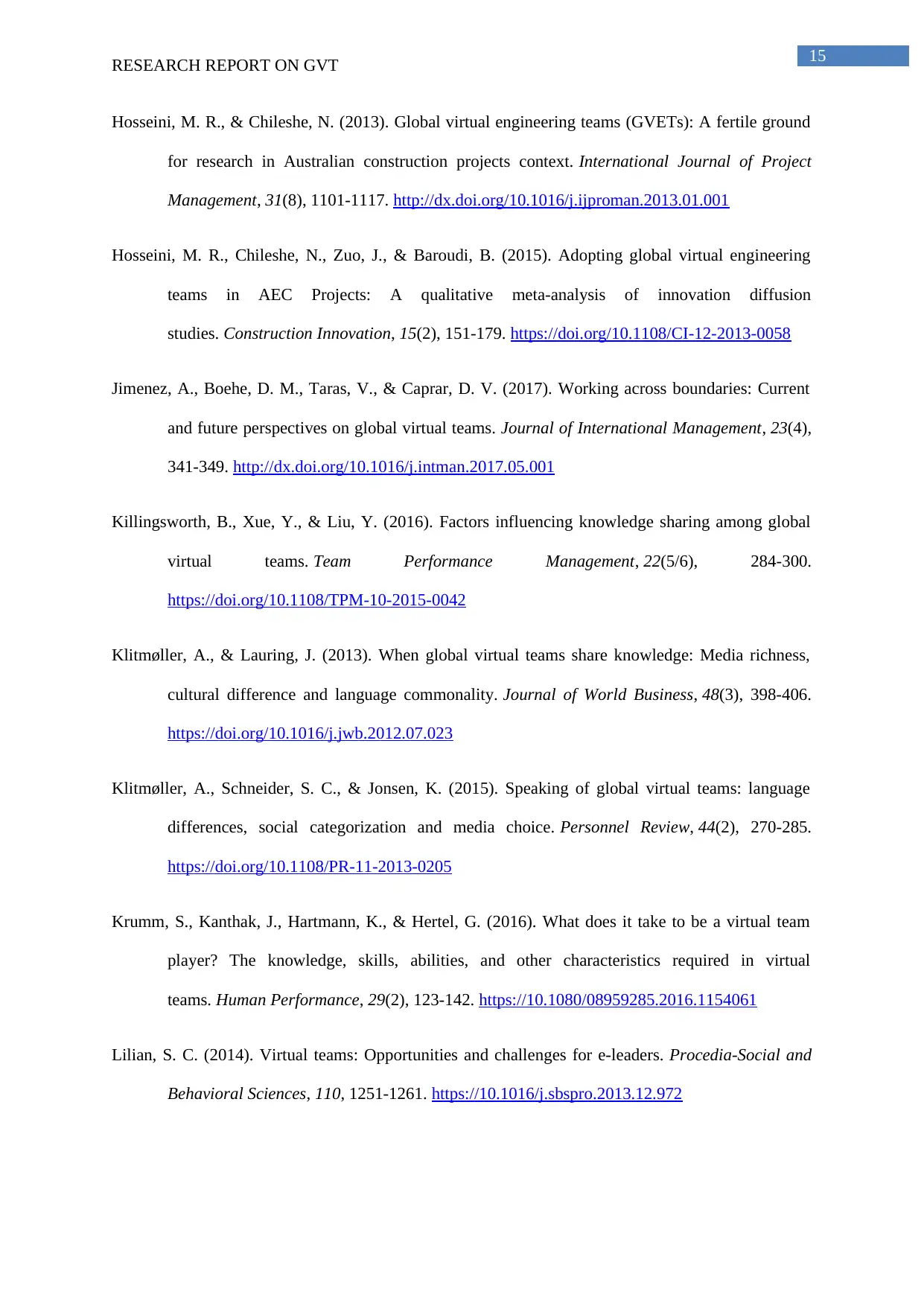
15
RESEARCH REPORT ON GVT
Hosseini, M. R., & Chileshe, N. (2013). Global virtual engineering teams (GVETs): A fertile ground
for research in Australian construction projects context. International Journal of Project
Management, 31(8), 1101-1117. http://dx.doi.org/10.1016/j.ijproman.2013.01.001
Hosseini, M. R., Chileshe, N., Zuo, J., & Baroudi, B. (2015). Adopting global virtual engineering
teams in AEC Projects: A qualitative meta-analysis of innovation diffusion
studies. Construction Innovation, 15(2), 151-179. https://doi.org/10.1108/CI-12-2013-0058
Jimenez, A., Boehe, D. M., Taras, V., & Caprar, D. V. (2017). Working across boundaries: Current
and future perspectives on global virtual teams. Journal of International Management, 23(4),
341-349. http://dx.doi.org/10.1016/j.intman.2017.05.001
Killingsworth, B., Xue, Y., & Liu, Y. (2016). Factors influencing knowledge sharing among global
virtual teams. Team Performance Management, 22(5/6), 284-300.
https://doi.org/10.1108/TPM-10-2015-0042
Klitmøller, A., & Lauring, J. (2013). When global virtual teams share knowledge: Media richness,
cultural difference and language commonality. Journal of World Business, 48(3), 398-406.
https://doi.org/10.1016/j.jwb.2012.07.023
Klitmøller, A., Schneider, S. C., & Jonsen, K. (2015). Speaking of global virtual teams: language
differences, social categorization and media choice. Personnel Review, 44(2), 270-285.
https://doi.org/10.1108/PR-11-2013-0205
Krumm, S., Kanthak, J., Hartmann, K., & Hertel, G. (2016). What does it take to be a virtual team
player? The knowledge, skills, abilities, and other characteristics required in virtual
teams. Human Performance, 29(2), 123-142. https://10.1080/08959285.2016.1154061
Lilian, S. C. (2014). Virtual teams: Opportunities and challenges for e-leaders. Procedia-Social and
Behavioral Sciences, 110, 1251-1261. https://10.1016/j.sbspro.2013.12.972
RESEARCH REPORT ON GVT
Hosseini, M. R., & Chileshe, N. (2013). Global virtual engineering teams (GVETs): A fertile ground
for research in Australian construction projects context. International Journal of Project
Management, 31(8), 1101-1117. http://dx.doi.org/10.1016/j.ijproman.2013.01.001
Hosseini, M. R., Chileshe, N., Zuo, J., & Baroudi, B. (2015). Adopting global virtual engineering
teams in AEC Projects: A qualitative meta-analysis of innovation diffusion
studies. Construction Innovation, 15(2), 151-179. https://doi.org/10.1108/CI-12-2013-0058
Jimenez, A., Boehe, D. M., Taras, V., & Caprar, D. V. (2017). Working across boundaries: Current
and future perspectives on global virtual teams. Journal of International Management, 23(4),
341-349. http://dx.doi.org/10.1016/j.intman.2017.05.001
Killingsworth, B., Xue, Y., & Liu, Y. (2016). Factors influencing knowledge sharing among global
virtual teams. Team Performance Management, 22(5/6), 284-300.
https://doi.org/10.1108/TPM-10-2015-0042
Klitmøller, A., & Lauring, J. (2013). When global virtual teams share knowledge: Media richness,
cultural difference and language commonality. Journal of World Business, 48(3), 398-406.
https://doi.org/10.1016/j.jwb.2012.07.023
Klitmøller, A., Schneider, S. C., & Jonsen, K. (2015). Speaking of global virtual teams: language
differences, social categorization and media choice. Personnel Review, 44(2), 270-285.
https://doi.org/10.1108/PR-11-2013-0205
Krumm, S., Kanthak, J., Hartmann, K., & Hertel, G. (2016). What does it take to be a virtual team
player? The knowledge, skills, abilities, and other characteristics required in virtual
teams. Human Performance, 29(2), 123-142. https://10.1080/08959285.2016.1154061
Lilian, S. C. (2014). Virtual teams: Opportunities and challenges for e-leaders. Procedia-Social and
Behavioral Sciences, 110, 1251-1261. https://10.1016/j.sbspro.2013.12.972
Secure Best Marks with AI Grader
Need help grading? Try our AI Grader for instant feedback on your assignments.
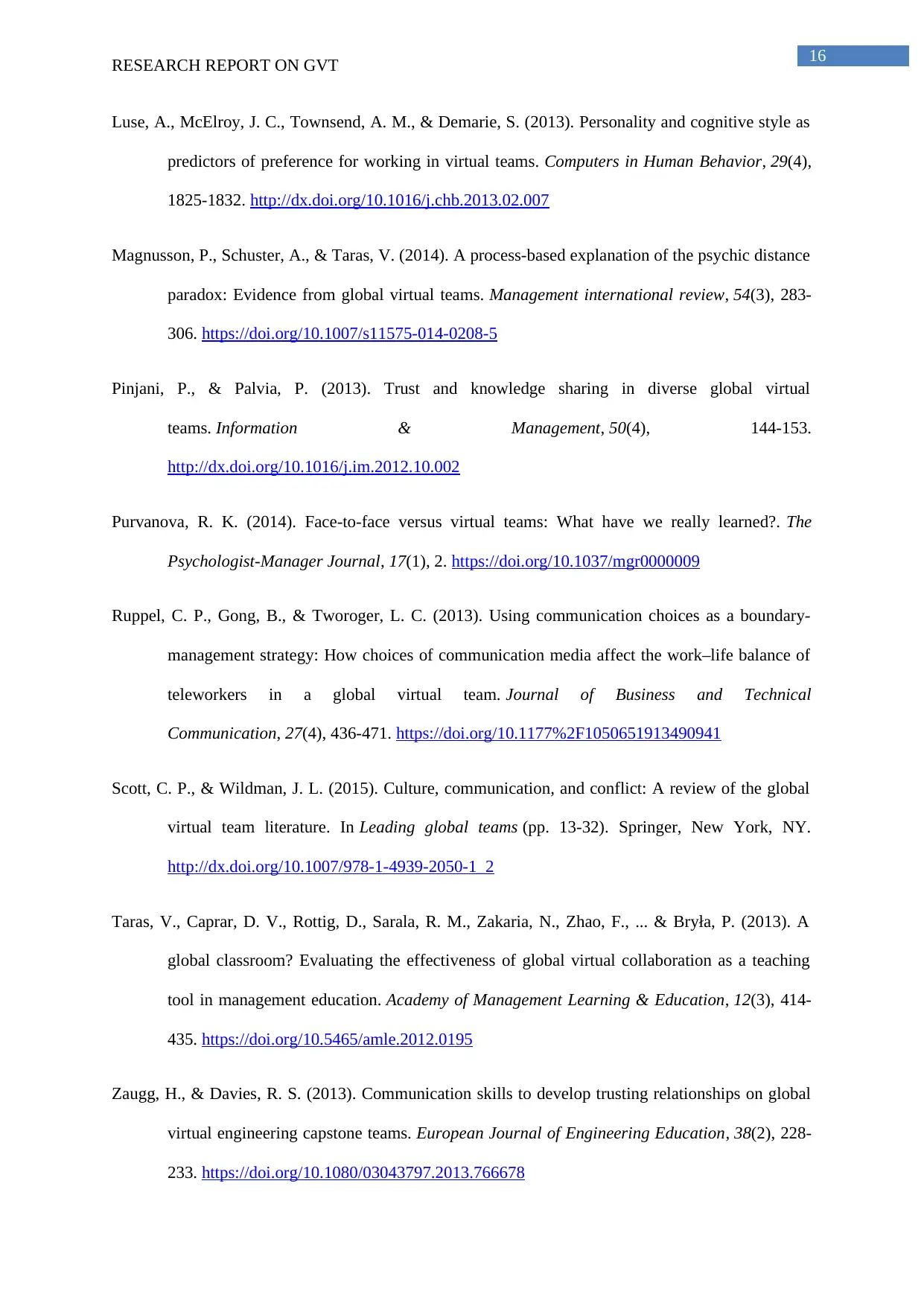
16
RESEARCH REPORT ON GVT
Luse, A., McElroy, J. C., Townsend, A. M., & Demarie, S. (2013). Personality and cognitive style as
predictors of preference for working in virtual teams. Computers in Human Behavior, 29(4),
1825-1832. http://dx.doi.org/10.1016/j.chb.2013.02.007
Magnusson, P., Schuster, A., & Taras, V. (2014). A process-based explanation of the psychic distance
paradox: Evidence from global virtual teams. Management international review, 54(3), 283-
306. https://doi.org/10.1007/s11575-014-0208-5
Pinjani, P., & Palvia, P. (2013). Trust and knowledge sharing in diverse global virtual
teams. Information & Management, 50(4), 144-153.
http://dx.doi.org/10.1016/j.im.2012.10.002
Purvanova, R. K. (2014). Face-to-face versus virtual teams: What have we really learned?. The
Psychologist-Manager Journal, 17(1), 2. https://doi.org/10.1037/mgr0000009
Ruppel, C. P., Gong, B., & Tworoger, L. C. (2013). Using communication choices as a boundary-
management strategy: How choices of communication media affect the work–life balance of
teleworkers in a global virtual team. Journal of Business and Technical
Communication, 27(4), 436-471. https://doi.org/10.1177%2F1050651913490941
Scott, C. P., & Wildman, J. L. (2015). Culture, communication, and conflict: A review of the global
virtual team literature. In Leading global teams (pp. 13-32). Springer, New York, NY.
http://dx.doi.org/10.1007/978-1-4939-2050-1_2
Taras, V., Caprar, D. V., Rottig, D., Sarala, R. M., Zakaria, N., Zhao, F., ... & Bryła, P. (2013). A
global classroom? Evaluating the effectiveness of global virtual collaboration as a teaching
tool in management education. Academy of Management Learning & Education, 12(3), 414-
435. https://doi.org/10.5465/amle.2012.0195
Zaugg, H., & Davies, R. S. (2013). Communication skills to develop trusting relationships on global
virtual engineering capstone teams. European Journal of Engineering Education, 38(2), 228-
233. https://doi.org/10.1080/03043797.2013.766678
RESEARCH REPORT ON GVT
Luse, A., McElroy, J. C., Townsend, A. M., & Demarie, S. (2013). Personality and cognitive style as
predictors of preference for working in virtual teams. Computers in Human Behavior, 29(4),
1825-1832. http://dx.doi.org/10.1016/j.chb.2013.02.007
Magnusson, P., Schuster, A., & Taras, V. (2014). A process-based explanation of the psychic distance
paradox: Evidence from global virtual teams. Management international review, 54(3), 283-
306. https://doi.org/10.1007/s11575-014-0208-5
Pinjani, P., & Palvia, P. (2013). Trust and knowledge sharing in diverse global virtual
teams. Information & Management, 50(4), 144-153.
http://dx.doi.org/10.1016/j.im.2012.10.002
Purvanova, R. K. (2014). Face-to-face versus virtual teams: What have we really learned?. The
Psychologist-Manager Journal, 17(1), 2. https://doi.org/10.1037/mgr0000009
Ruppel, C. P., Gong, B., & Tworoger, L. C. (2013). Using communication choices as a boundary-
management strategy: How choices of communication media affect the work–life balance of
teleworkers in a global virtual team. Journal of Business and Technical
Communication, 27(4), 436-471. https://doi.org/10.1177%2F1050651913490941
Scott, C. P., & Wildman, J. L. (2015). Culture, communication, and conflict: A review of the global
virtual team literature. In Leading global teams (pp. 13-32). Springer, New York, NY.
http://dx.doi.org/10.1007/978-1-4939-2050-1_2
Taras, V., Caprar, D. V., Rottig, D., Sarala, R. M., Zakaria, N., Zhao, F., ... & Bryła, P. (2013). A
global classroom? Evaluating the effectiveness of global virtual collaboration as a teaching
tool in management education. Academy of Management Learning & Education, 12(3), 414-
435. https://doi.org/10.5465/amle.2012.0195
Zaugg, H., & Davies, R. S. (2013). Communication skills to develop trusting relationships on global
virtual engineering capstone teams. European Journal of Engineering Education, 38(2), 228-
233. https://doi.org/10.1080/03043797.2013.766678
1 out of 17
Related Documents
Your All-in-One AI-Powered Toolkit for Academic Success.
+13062052269
info@desklib.com
Available 24*7 on WhatsApp / Email
![[object Object]](/_next/static/media/star-bottom.7253800d.svg)
Unlock your academic potential
© 2024 | Zucol Services PVT LTD | All rights reserved.





